Attractiveness of Universal Studio Singapore (USS) among International Visitors
VerifiedAdded on 2023/06/03
|25
|5616
|245
AI Summary
This research paper discusses the attractiveness of Universal Studio Singapore (USS) among international visitors. It covers the nature of urban tourism, Singapore as a business hub and leisure island, literature review on tourist motivation, adventure travel and tourism, consumption, tourist typologies, tourist enclaves and bubbles, management, business and marketing concepts. The paper provides findings and recommendations for USS.
Contribute Materials
Your contribution can guide someone’s learning journey. Share your
documents today.
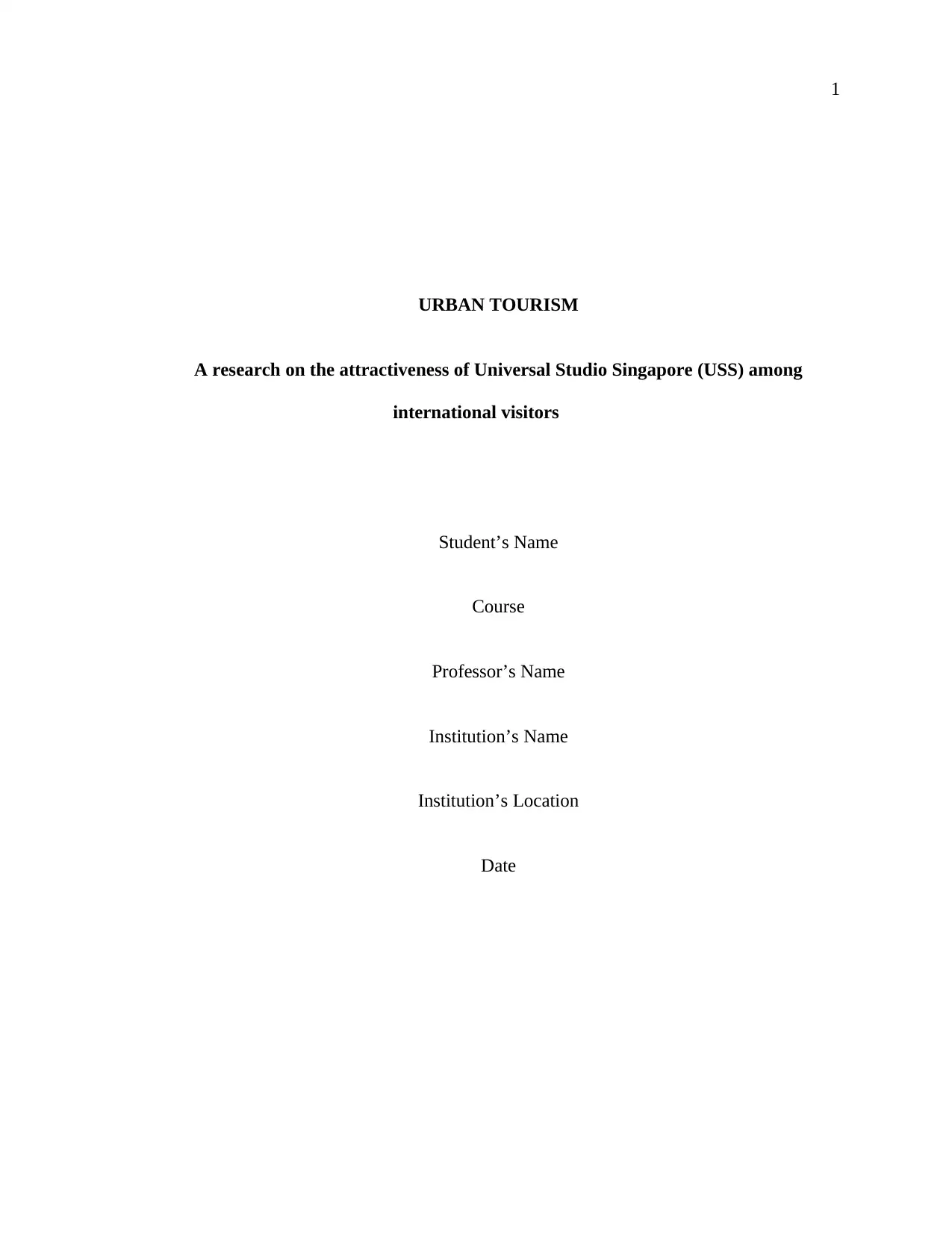
1
URBAN TOURISM
A research on the attractiveness of Universal Studio Singapore (USS) among
international visitors
Student’s Name
Course
Professor’s Name
Institution’s Name
Institution’s Location
Date
URBAN TOURISM
A research on the attractiveness of Universal Studio Singapore (USS) among
international visitors
Student’s Name
Course
Professor’s Name
Institution’s Name
Institution’s Location
Date
Secure Best Marks with AI Grader
Need help grading? Try our AI Grader for instant feedback on your assignments.
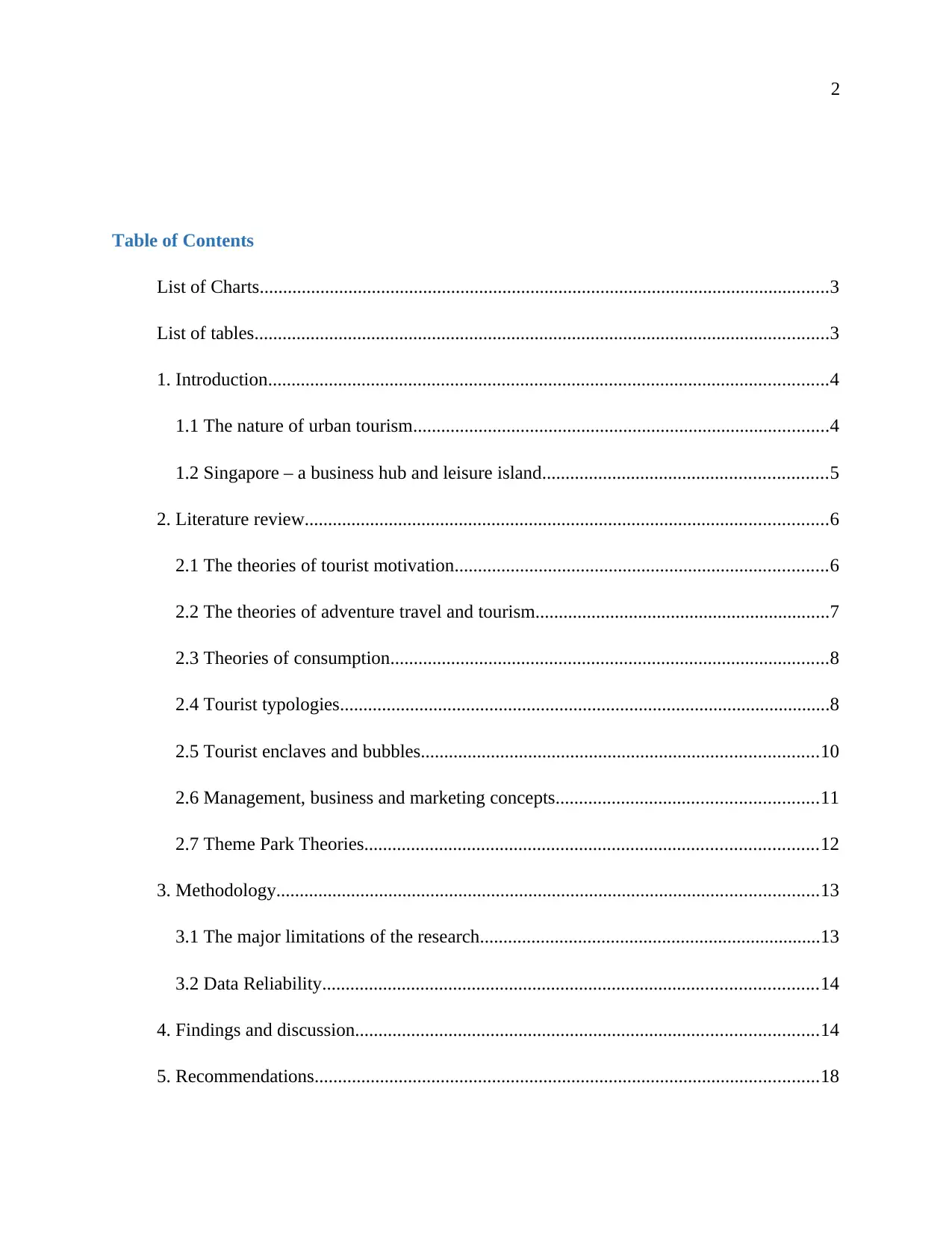
2
Table of Contents
List of Charts..........................................................................................................................3
List of tables...........................................................................................................................3
1. Introduction........................................................................................................................4
1.1 The nature of urban tourism.........................................................................................4
1.2 Singapore – a business hub and leisure island.............................................................5
2. Literature review................................................................................................................6
2.1 The theories of tourist motivation................................................................................6
2.2 The theories of adventure travel and tourism...............................................................7
2.3 Theories of consumption..............................................................................................8
2.4 Tourist typologies.........................................................................................................8
2.5 Tourist enclaves and bubbles.....................................................................................10
2.6 Management, business and marketing concepts........................................................11
2.7 Theme Park Theories.................................................................................................12
3. Methodology....................................................................................................................13
3.1 The major limitations of the research.........................................................................13
3.2 Data Reliability..........................................................................................................14
4. Findings and discussion...................................................................................................14
5. Recommendations............................................................................................................18
Table of Contents
List of Charts..........................................................................................................................3
List of tables...........................................................................................................................3
1. Introduction........................................................................................................................4
1.1 The nature of urban tourism.........................................................................................4
1.2 Singapore – a business hub and leisure island.............................................................5
2. Literature review................................................................................................................6
2.1 The theories of tourist motivation................................................................................6
2.2 The theories of adventure travel and tourism...............................................................7
2.3 Theories of consumption..............................................................................................8
2.4 Tourist typologies.........................................................................................................8
2.5 Tourist enclaves and bubbles.....................................................................................10
2.6 Management, business and marketing concepts........................................................11
2.7 Theme Park Theories.................................................................................................12
3. Methodology....................................................................................................................13
3.1 The major limitations of the research.........................................................................13
3.2 Data Reliability..........................................................................................................14
4. Findings and discussion...................................................................................................14
5. Recommendations............................................................................................................18
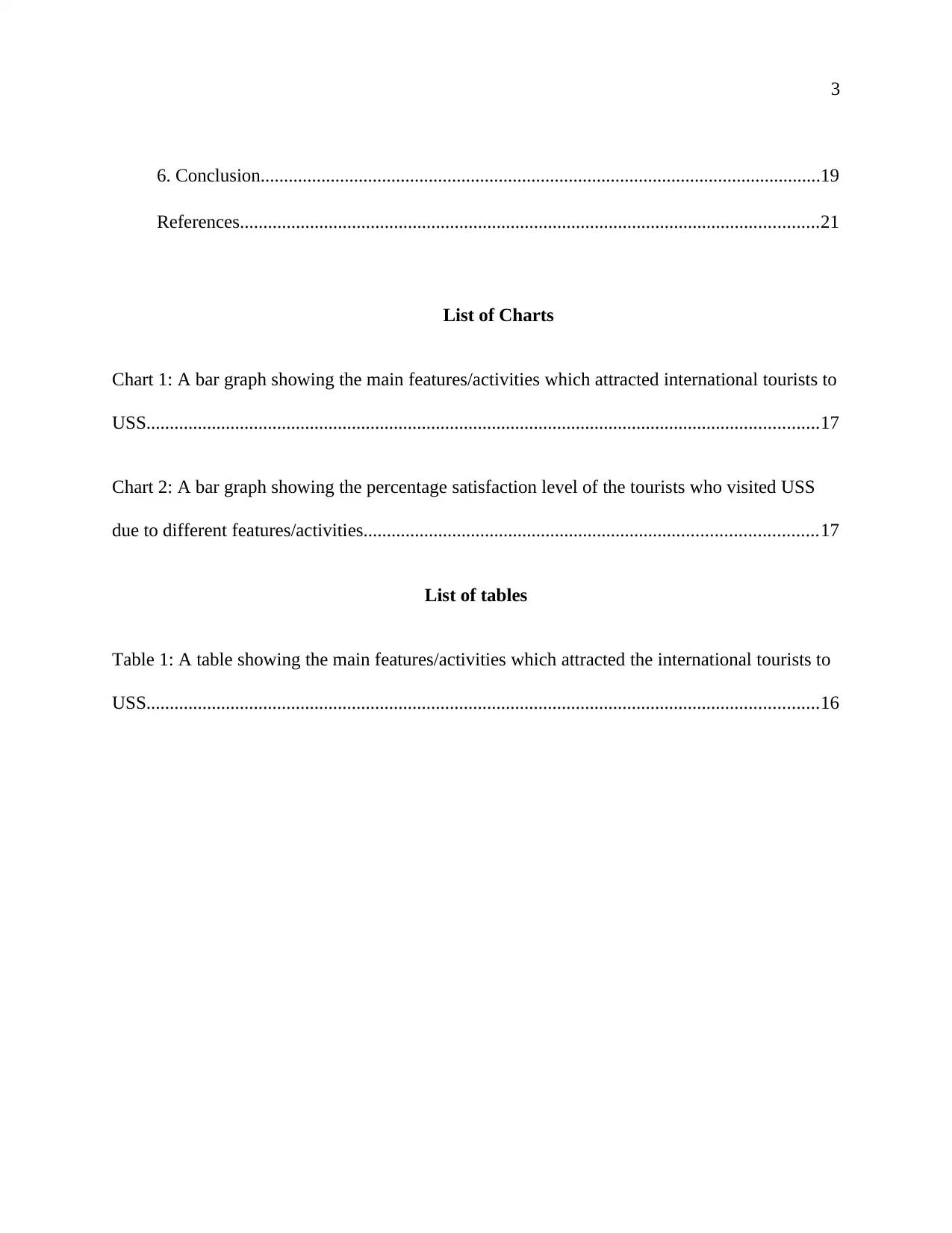
3
6. Conclusion........................................................................................................................19
References............................................................................................................................21
List of Charts
Chart 1: A bar graph showing the main features/activities which attracted international tourists to
USS................................................................................................................................................17
Chart 2: A bar graph showing the percentage satisfaction level of the tourists who visited USS
due to different features/activities.................................................................................................17
List of tables
Table 1: A table showing the main features/activities which attracted the international tourists to
USS................................................................................................................................................16
6. Conclusion........................................................................................................................19
References............................................................................................................................21
List of Charts
Chart 1: A bar graph showing the main features/activities which attracted international tourists to
USS................................................................................................................................................17
Chart 2: A bar graph showing the percentage satisfaction level of the tourists who visited USS
due to different features/activities.................................................................................................17
List of tables
Table 1: A table showing the main features/activities which attracted the international tourists to
USS................................................................................................................................................16
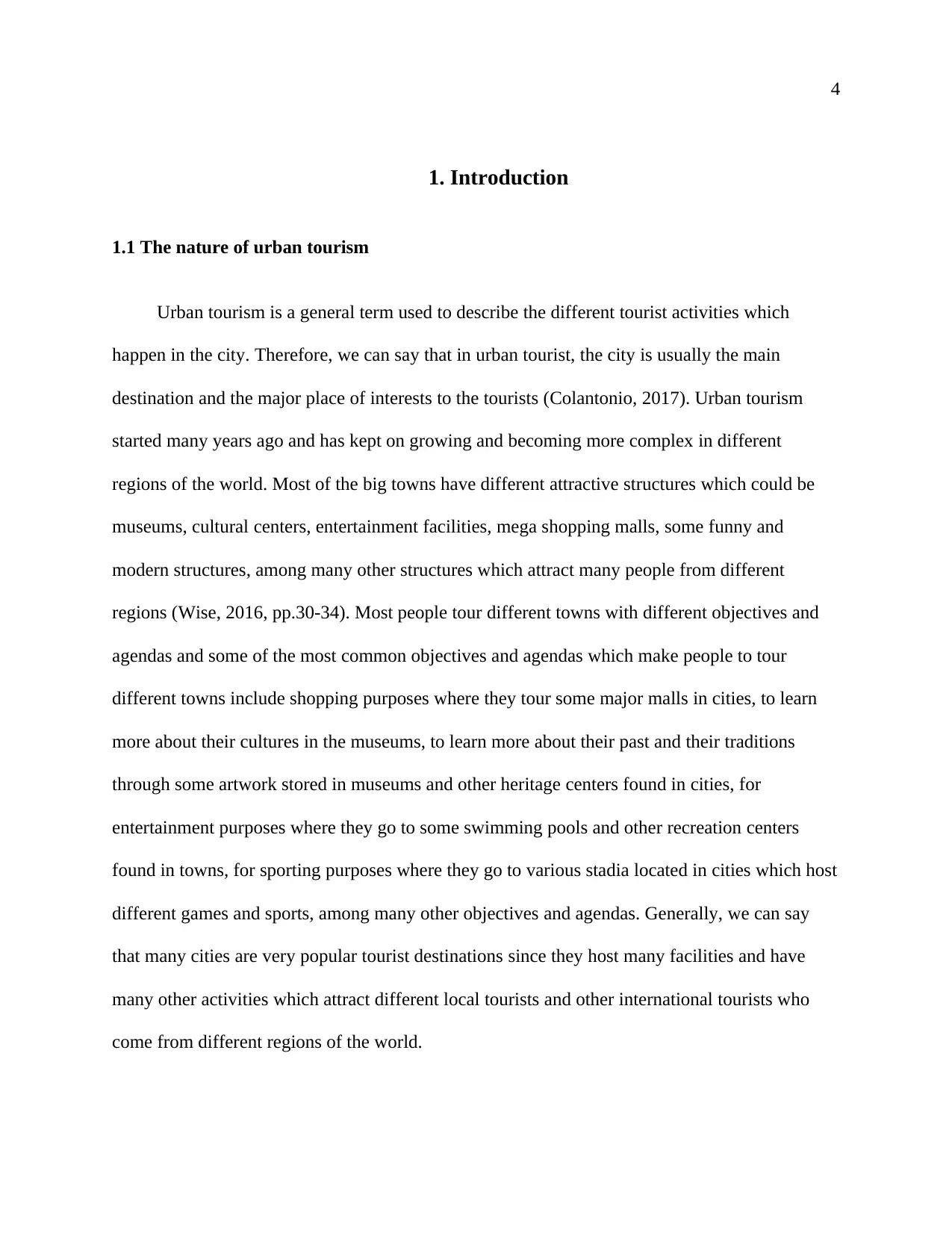
4
1. Introduction
1.1 The nature of urban tourism
Urban tourism is a general term used to describe the different tourist activities which
happen in the city. Therefore, we can say that in urban tourist, the city is usually the main
destination and the major place of interests to the tourists (Colantonio, 2017). Urban tourism
started many years ago and has kept on growing and becoming more complex in different
regions of the world. Most of the big towns have different attractive structures which could be
museums, cultural centers, entertainment facilities, mega shopping malls, some funny and
modern structures, among many other structures which attract many people from different
regions (Wise, 2016, pp.30-34). Most people tour different towns with different objectives and
agendas and some of the most common objectives and agendas which make people to tour
different towns include shopping purposes where they tour some major malls in cities, to learn
more about their cultures in the museums, to learn more about their past and their traditions
through some artwork stored in museums and other heritage centers found in cities, for
entertainment purposes where they go to some swimming pools and other recreation centers
found in towns, for sporting purposes where they go to various stadia located in cities which host
different games and sports, among many other objectives and agendas. Generally, we can say
that many cities are very popular tourist destinations since they host many facilities and have
many other activities which attract different local tourists and other international tourists who
come from different regions of the world.
1. Introduction
1.1 The nature of urban tourism
Urban tourism is a general term used to describe the different tourist activities which
happen in the city. Therefore, we can say that in urban tourist, the city is usually the main
destination and the major place of interests to the tourists (Colantonio, 2017). Urban tourism
started many years ago and has kept on growing and becoming more complex in different
regions of the world. Most of the big towns have different attractive structures which could be
museums, cultural centers, entertainment facilities, mega shopping malls, some funny and
modern structures, among many other structures which attract many people from different
regions (Wise, 2016, pp.30-34). Most people tour different towns with different objectives and
agendas and some of the most common objectives and agendas which make people to tour
different towns include shopping purposes where they tour some major malls in cities, to learn
more about their cultures in the museums, to learn more about their past and their traditions
through some artwork stored in museums and other heritage centers found in cities, for
entertainment purposes where they go to some swimming pools and other recreation centers
found in towns, for sporting purposes where they go to various stadia located in cities which host
different games and sports, among many other objectives and agendas. Generally, we can say
that many cities are very popular tourist destinations since they host many facilities and have
many other activities which attract different local tourists and other international tourists who
come from different regions of the world.
Secure Best Marks with AI Grader
Need help grading? Try our AI Grader for instant feedback on your assignments.
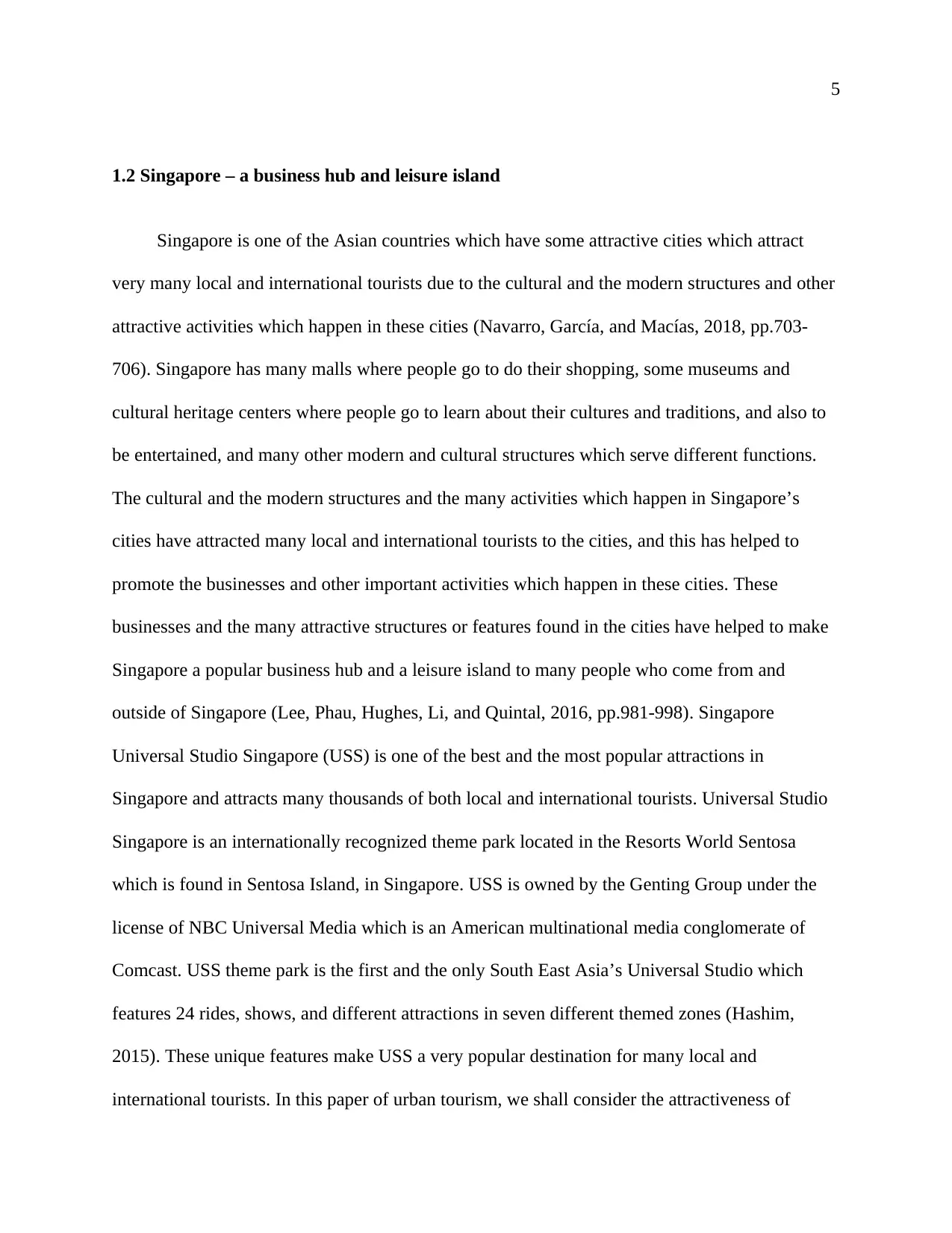
5
1.2 Singapore – a business hub and leisure island
Singapore is one of the Asian countries which have some attractive cities which attract
very many local and international tourists due to the cultural and the modern structures and other
attractive activities which happen in these cities (Navarro, García, and Macías, 2018, pp.703-
706). Singapore has many malls where people go to do their shopping, some museums and
cultural heritage centers where people go to learn about their cultures and traditions, and also to
be entertained, and many other modern and cultural structures which serve different functions.
The cultural and the modern structures and the many activities which happen in Singapore’s
cities have attracted many local and international tourists to the cities, and this has helped to
promote the businesses and other important activities which happen in these cities. These
businesses and the many attractive structures or features found in the cities have helped to make
Singapore a popular business hub and a leisure island to many people who come from and
outside of Singapore (Lee, Phau, Hughes, Li, and Quintal, 2016, pp.981-998). Singapore
Universal Studio Singapore (USS) is one of the best and the most popular attractions in
Singapore and attracts many thousands of both local and international tourists. Universal Studio
Singapore is an internationally recognized theme park located in the Resorts World Sentosa
which is found in Sentosa Island, in Singapore. USS is owned by the Genting Group under the
license of NBC Universal Media which is an American multinational media conglomerate of
Comcast. USS theme park is the first and the only South East Asia’s Universal Studio which
features 24 rides, shows, and different attractions in seven different themed zones (Hashim,
2015). These unique features make USS a very popular destination for many local and
international tourists. In this paper of urban tourism, we shall consider the attractiveness of
1.2 Singapore – a business hub and leisure island
Singapore is one of the Asian countries which have some attractive cities which attract
very many local and international tourists due to the cultural and the modern structures and other
attractive activities which happen in these cities (Navarro, García, and Macías, 2018, pp.703-
706). Singapore has many malls where people go to do their shopping, some museums and
cultural heritage centers where people go to learn about their cultures and traditions, and also to
be entertained, and many other modern and cultural structures which serve different functions.
The cultural and the modern structures and the many activities which happen in Singapore’s
cities have attracted many local and international tourists to the cities, and this has helped to
promote the businesses and other important activities which happen in these cities. These
businesses and the many attractive structures or features found in the cities have helped to make
Singapore a popular business hub and a leisure island to many people who come from and
outside of Singapore (Lee, Phau, Hughes, Li, and Quintal, 2016, pp.981-998). Singapore
Universal Studio Singapore (USS) is one of the best and the most popular attractions in
Singapore and attracts many thousands of both local and international tourists. Universal Studio
Singapore is an internationally recognized theme park located in the Resorts World Sentosa
which is found in Sentosa Island, in Singapore. USS is owned by the Genting Group under the
license of NBC Universal Media which is an American multinational media conglomerate of
Comcast. USS theme park is the first and the only South East Asia’s Universal Studio which
features 24 rides, shows, and different attractions in seven different themed zones (Hashim,
2015). These unique features make USS a very popular destination for many local and
international tourists. In this paper of urban tourism, we shall consider the attractiveness of
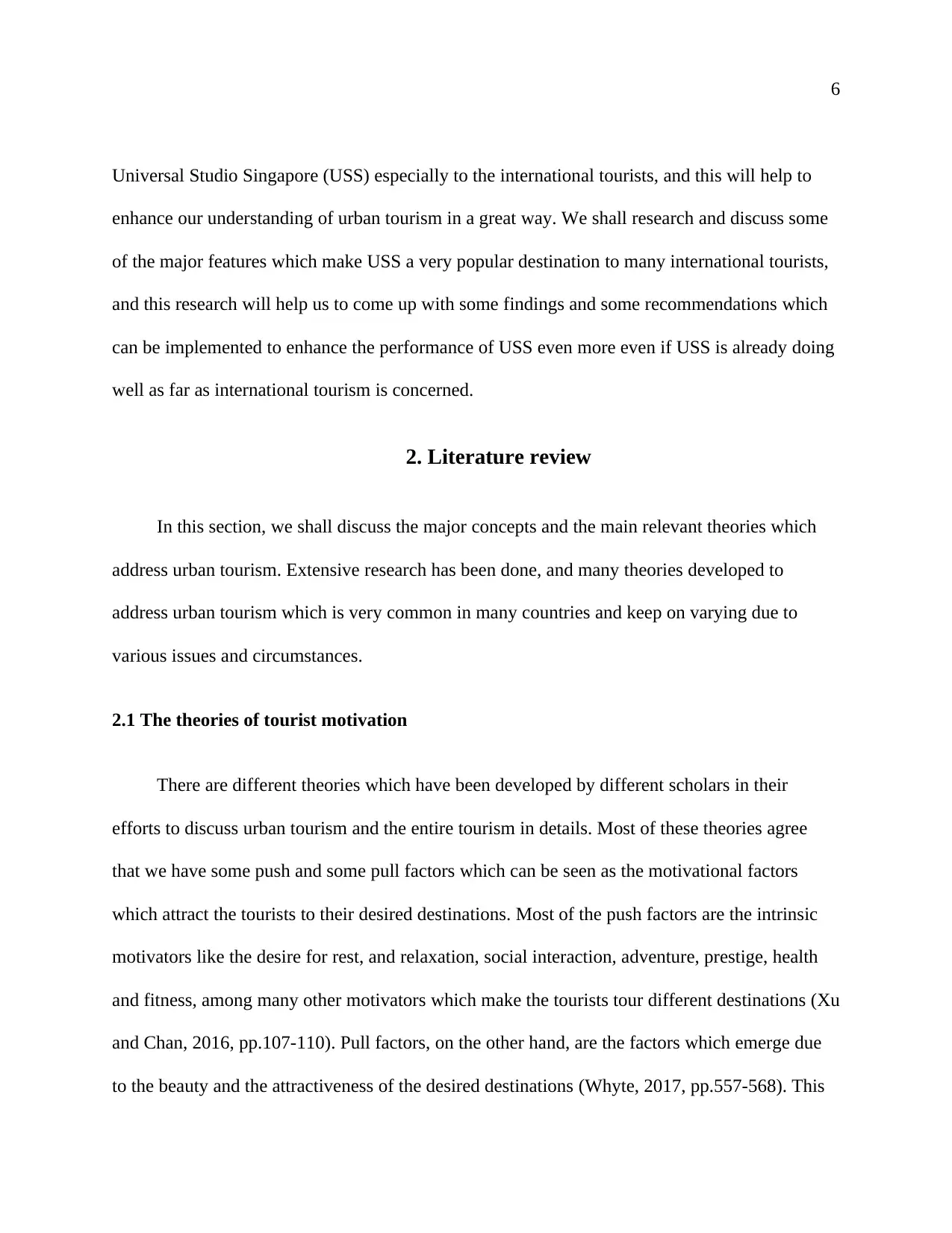
6
Universal Studio Singapore (USS) especially to the international tourists, and this will help to
enhance our understanding of urban tourism in a great way. We shall research and discuss some
of the major features which make USS a very popular destination to many international tourists,
and this research will help us to come up with some findings and some recommendations which
can be implemented to enhance the performance of USS even more even if USS is already doing
well as far as international tourism is concerned.
2. Literature review
In this section, we shall discuss the major concepts and the main relevant theories which
address urban tourism. Extensive research has been done, and many theories developed to
address urban tourism which is very common in many countries and keep on varying due to
various issues and circumstances.
2.1 The theories of tourist motivation
There are different theories which have been developed by different scholars in their
efforts to discuss urban tourism and the entire tourism in details. Most of these theories agree
that we have some push and some pull factors which can be seen as the motivational factors
which attract the tourists to their desired destinations. Most of the push factors are the intrinsic
motivators like the desire for rest, and relaxation, social interaction, adventure, prestige, health
and fitness, among many other motivators which make the tourists tour different destinations (Xu
and Chan, 2016, pp.107-110). Pull factors, on the other hand, are the factors which emerge due
to the beauty and the attractiveness of the desired destinations (Whyte, 2017, pp.557-568). This
Universal Studio Singapore (USS) especially to the international tourists, and this will help to
enhance our understanding of urban tourism in a great way. We shall research and discuss some
of the major features which make USS a very popular destination to many international tourists,
and this research will help us to come up with some findings and some recommendations which
can be implemented to enhance the performance of USS even more even if USS is already doing
well as far as international tourism is concerned.
2. Literature review
In this section, we shall discuss the major concepts and the main relevant theories which
address urban tourism. Extensive research has been done, and many theories developed to
address urban tourism which is very common in many countries and keep on varying due to
various issues and circumstances.
2.1 The theories of tourist motivation
There are different theories which have been developed by different scholars in their
efforts to discuss urban tourism and the entire tourism in details. Most of these theories agree
that we have some push and some pull factors which can be seen as the motivational factors
which attract the tourists to their desired destinations. Most of the push factors are the intrinsic
motivators like the desire for rest, and relaxation, social interaction, adventure, prestige, health
and fitness, among many other motivators which make the tourists tour different destinations (Xu
and Chan, 2016, pp.107-110). Pull factors, on the other hand, are the factors which emerge due
to the beauty and the attractiveness of the desired destinations (Whyte, 2017, pp.557-568). This
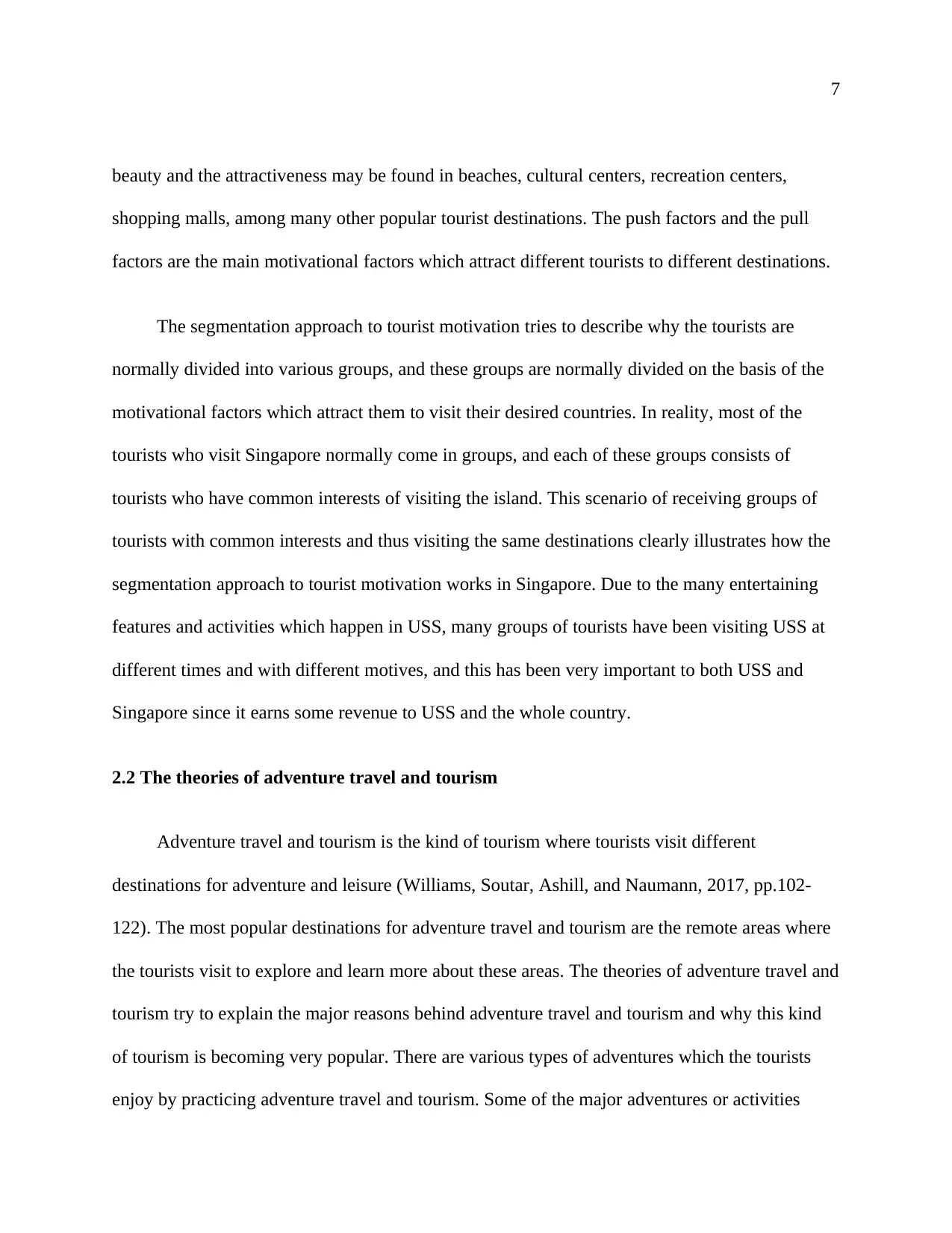
7
beauty and the attractiveness may be found in beaches, cultural centers, recreation centers,
shopping malls, among many other popular tourist destinations. The push factors and the pull
factors are the main motivational factors which attract different tourists to different destinations.
The segmentation approach to tourist motivation tries to describe why the tourists are
normally divided into various groups, and these groups are normally divided on the basis of the
motivational factors which attract them to visit their desired countries. In reality, most of the
tourists who visit Singapore normally come in groups, and each of these groups consists of
tourists who have common interests of visiting the island. This scenario of receiving groups of
tourists with common interests and thus visiting the same destinations clearly illustrates how the
segmentation approach to tourist motivation works in Singapore. Due to the many entertaining
features and activities which happen in USS, many groups of tourists have been visiting USS at
different times and with different motives, and this has been very important to both USS and
Singapore since it earns some revenue to USS and the whole country.
2.2 The theories of adventure travel and tourism
Adventure travel and tourism is the kind of tourism where tourists visit different
destinations for adventure and leisure (Williams, Soutar, Ashill, and Naumann, 2017, pp.102-
122). The most popular destinations for adventure travel and tourism are the remote areas where
the tourists visit to explore and learn more about these areas. The theories of adventure travel and
tourism try to explain the major reasons behind adventure travel and tourism and why this kind
of tourism is becoming very popular. There are various types of adventures which the tourists
enjoy by practicing adventure travel and tourism. Some of the major adventures or activities
beauty and the attractiveness may be found in beaches, cultural centers, recreation centers,
shopping malls, among many other popular tourist destinations. The push factors and the pull
factors are the main motivational factors which attract different tourists to different destinations.
The segmentation approach to tourist motivation tries to describe why the tourists are
normally divided into various groups, and these groups are normally divided on the basis of the
motivational factors which attract them to visit their desired countries. In reality, most of the
tourists who visit Singapore normally come in groups, and each of these groups consists of
tourists who have common interests of visiting the island. This scenario of receiving groups of
tourists with common interests and thus visiting the same destinations clearly illustrates how the
segmentation approach to tourist motivation works in Singapore. Due to the many entertaining
features and activities which happen in USS, many groups of tourists have been visiting USS at
different times and with different motives, and this has been very important to both USS and
Singapore since it earns some revenue to USS and the whole country.
2.2 The theories of adventure travel and tourism
Adventure travel and tourism is the kind of tourism where tourists visit different
destinations for adventure and leisure (Williams, Soutar, Ashill, and Naumann, 2017, pp.102-
122). The most popular destinations for adventure travel and tourism are the remote areas where
the tourists visit to explore and learn more about these areas. The theories of adventure travel and
tourism try to explain the major reasons behind adventure travel and tourism and why this kind
of tourism is becoming very popular. There are various types of adventures which the tourists
enjoy by practicing adventure travel and tourism. Some of the major adventures or activities
Paraphrase This Document
Need a fresh take? Get an instant paraphrase of this document with our AI Paraphraser
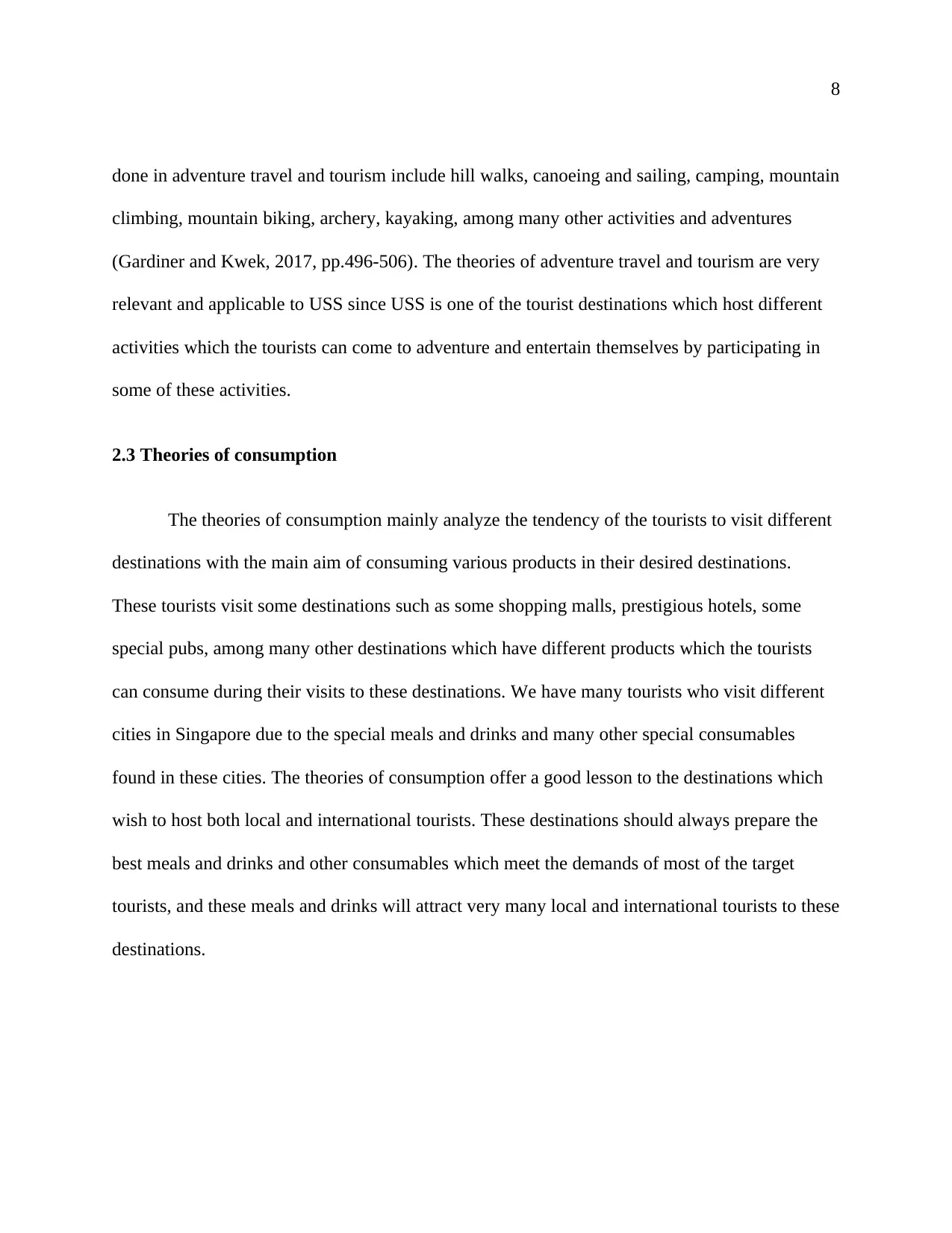
8
done in adventure travel and tourism include hill walks, canoeing and sailing, camping, mountain
climbing, mountain biking, archery, kayaking, among many other activities and adventures
(Gardiner and Kwek, 2017, pp.496-506). The theories of adventure travel and tourism are very
relevant and applicable to USS since USS is one of the tourist destinations which host different
activities which the tourists can come to adventure and entertain themselves by participating in
some of these activities.
2.3 Theories of consumption
The theories of consumption mainly analyze the tendency of the tourists to visit different
destinations with the main aim of consuming various products in their desired destinations.
These tourists visit some destinations such as some shopping malls, prestigious hotels, some
special pubs, among many other destinations which have different products which the tourists
can consume during their visits to these destinations. We have many tourists who visit different
cities in Singapore due to the special meals and drinks and many other special consumables
found in these cities. The theories of consumption offer a good lesson to the destinations which
wish to host both local and international tourists. These destinations should always prepare the
best meals and drinks and other consumables which meet the demands of most of the target
tourists, and these meals and drinks will attract very many local and international tourists to these
destinations.
done in adventure travel and tourism include hill walks, canoeing and sailing, camping, mountain
climbing, mountain biking, archery, kayaking, among many other activities and adventures
(Gardiner and Kwek, 2017, pp.496-506). The theories of adventure travel and tourism are very
relevant and applicable to USS since USS is one of the tourist destinations which host different
activities which the tourists can come to adventure and entertain themselves by participating in
some of these activities.
2.3 Theories of consumption
The theories of consumption mainly analyze the tendency of the tourists to visit different
destinations with the main aim of consuming various products in their desired destinations.
These tourists visit some destinations such as some shopping malls, prestigious hotels, some
special pubs, among many other destinations which have different products which the tourists
can consume during their visits to these destinations. We have many tourists who visit different
cities in Singapore due to the special meals and drinks and many other special consumables
found in these cities. The theories of consumption offer a good lesson to the destinations which
wish to host both local and international tourists. These destinations should always prepare the
best meals and drinks and other consumables which meet the demands of most of the target
tourists, and these meals and drinks will attract very many local and international tourists to these
destinations.
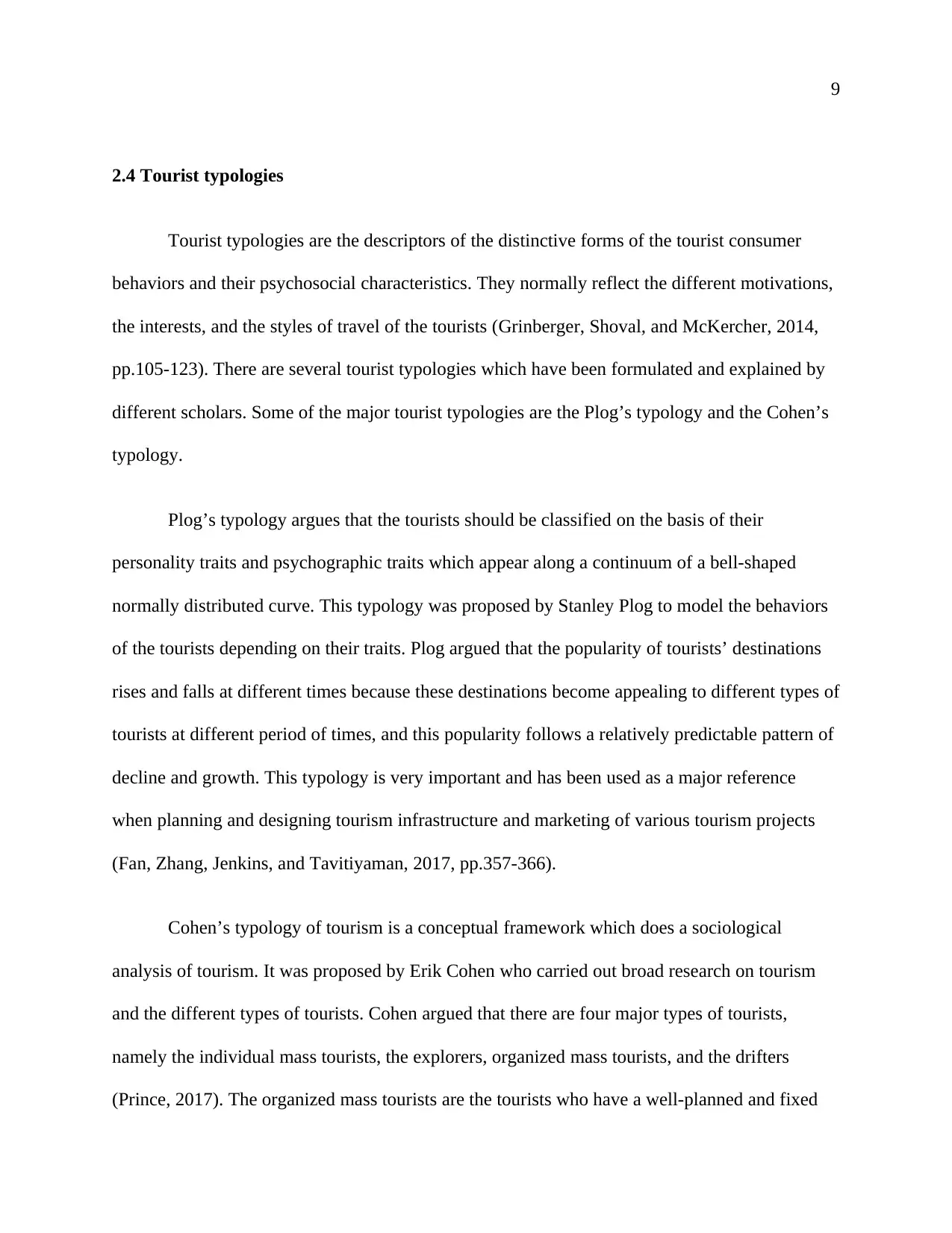
9
2.4 Tourist typologies
Tourist typologies are the descriptors of the distinctive forms of the tourist consumer
behaviors and their psychosocial characteristics. They normally reflect the different motivations,
the interests, and the styles of travel of the tourists (Grinberger, Shoval, and McKercher, 2014,
pp.105-123). There are several tourist typologies which have been formulated and explained by
different scholars. Some of the major tourist typologies are the Plog’s typology and the Cohen’s
typology.
Plog’s typology argues that the tourists should be classified on the basis of their
personality traits and psychographic traits which appear along a continuum of a bell-shaped
normally distributed curve. This typology was proposed by Stanley Plog to model the behaviors
of the tourists depending on their traits. Plog argued that the popularity of tourists’ destinations
rises and falls at different times because these destinations become appealing to different types of
tourists at different period of times, and this popularity follows a relatively predictable pattern of
decline and growth. This typology is very important and has been used as a major reference
when planning and designing tourism infrastructure and marketing of various tourism projects
(Fan, Zhang, Jenkins, and Tavitiyaman, 2017, pp.357-366).
Cohen’s typology of tourism is a conceptual framework which does a sociological
analysis of tourism. It was proposed by Erik Cohen who carried out broad research on tourism
and the different types of tourists. Cohen argued that there are four major types of tourists,
namely the individual mass tourists, the explorers, organized mass tourists, and the drifters
(Prince, 2017). The organized mass tourists are the tourists who have a well-planned and fixed
2.4 Tourist typologies
Tourist typologies are the descriptors of the distinctive forms of the tourist consumer
behaviors and their psychosocial characteristics. They normally reflect the different motivations,
the interests, and the styles of travel of the tourists (Grinberger, Shoval, and McKercher, 2014,
pp.105-123). There are several tourist typologies which have been formulated and explained by
different scholars. Some of the major tourist typologies are the Plog’s typology and the Cohen’s
typology.
Plog’s typology argues that the tourists should be classified on the basis of their
personality traits and psychographic traits which appear along a continuum of a bell-shaped
normally distributed curve. This typology was proposed by Stanley Plog to model the behaviors
of the tourists depending on their traits. Plog argued that the popularity of tourists’ destinations
rises and falls at different times because these destinations become appealing to different types of
tourists at different period of times, and this popularity follows a relatively predictable pattern of
decline and growth. This typology is very important and has been used as a major reference
when planning and designing tourism infrastructure and marketing of various tourism projects
(Fan, Zhang, Jenkins, and Tavitiyaman, 2017, pp.357-366).
Cohen’s typology of tourism is a conceptual framework which does a sociological
analysis of tourism. It was proposed by Erik Cohen who carried out broad research on tourism
and the different types of tourists. Cohen argued that there are four major types of tourists,
namely the individual mass tourists, the explorers, organized mass tourists, and the drifters
(Prince, 2017). The organized mass tourists are the tourists who have a well-planned and fixed
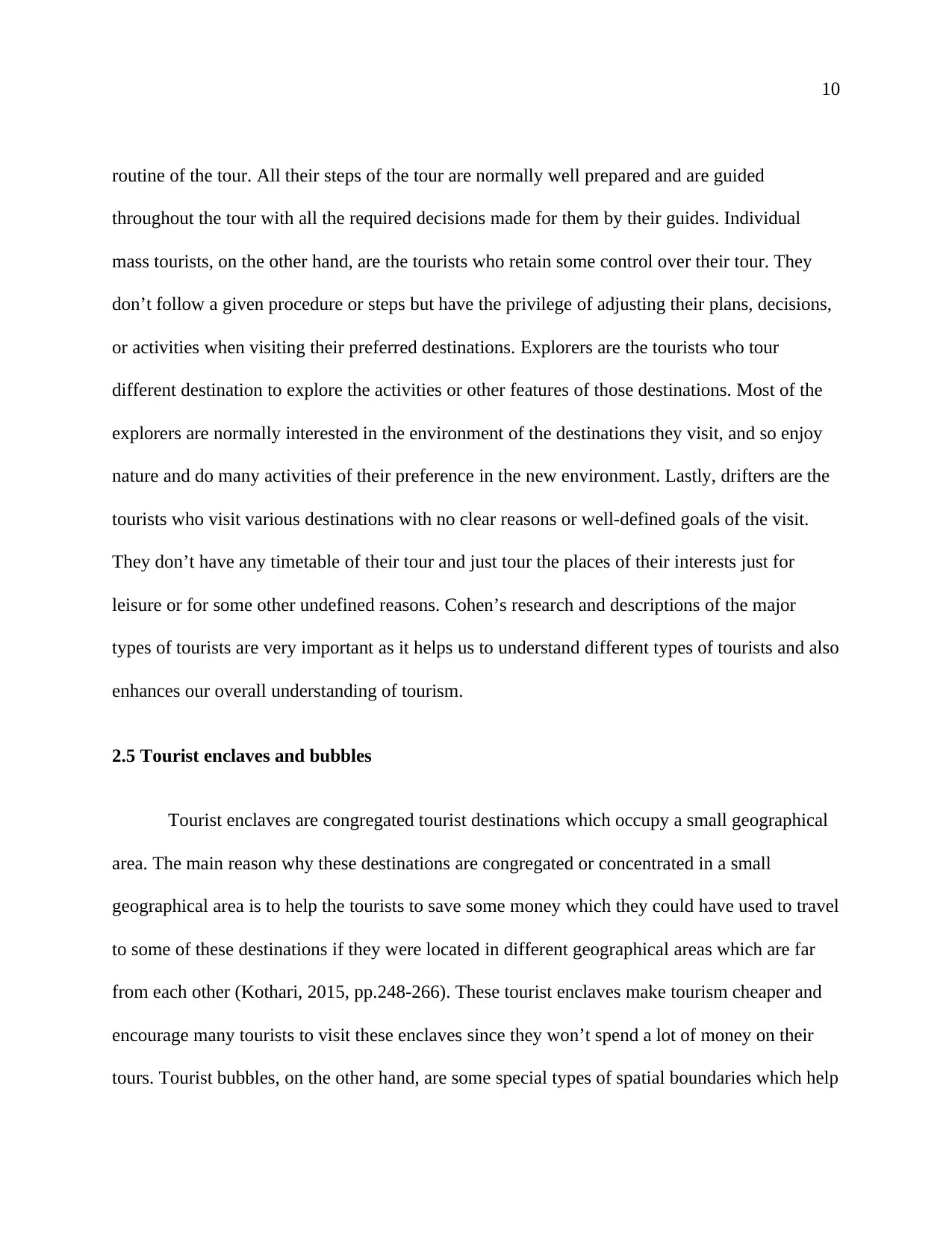
10
routine of the tour. All their steps of the tour are normally well prepared and are guided
throughout the tour with all the required decisions made for them by their guides. Individual
mass tourists, on the other hand, are the tourists who retain some control over their tour. They
don’t follow a given procedure or steps but have the privilege of adjusting their plans, decisions,
or activities when visiting their preferred destinations. Explorers are the tourists who tour
different destination to explore the activities or other features of those destinations. Most of the
explorers are normally interested in the environment of the destinations they visit, and so enjoy
nature and do many activities of their preference in the new environment. Lastly, drifters are the
tourists who visit various destinations with no clear reasons or well-defined goals of the visit.
They don’t have any timetable of their tour and just tour the places of their interests just for
leisure or for some other undefined reasons. Cohen’s research and descriptions of the major
types of tourists are very important as it helps us to understand different types of tourists and also
enhances our overall understanding of tourism.
2.5 Tourist enclaves and bubbles
Tourist enclaves are congregated tourist destinations which occupy a small geographical
area. The main reason why these destinations are congregated or concentrated in a small
geographical area is to help the tourists to save some money which they could have used to travel
to some of these destinations if they were located in different geographical areas which are far
from each other (Kothari, 2015, pp.248-266). These tourist enclaves make tourism cheaper and
encourage many tourists to visit these enclaves since they won’t spend a lot of money on their
tours. Tourist bubbles, on the other hand, are some special types of spatial boundaries which help
routine of the tour. All their steps of the tour are normally well prepared and are guided
throughout the tour with all the required decisions made for them by their guides. Individual
mass tourists, on the other hand, are the tourists who retain some control over their tour. They
don’t follow a given procedure or steps but have the privilege of adjusting their plans, decisions,
or activities when visiting their preferred destinations. Explorers are the tourists who tour
different destination to explore the activities or other features of those destinations. Most of the
explorers are normally interested in the environment of the destinations they visit, and so enjoy
nature and do many activities of their preference in the new environment. Lastly, drifters are the
tourists who visit various destinations with no clear reasons or well-defined goals of the visit.
They don’t have any timetable of their tour and just tour the places of their interests just for
leisure or for some other undefined reasons. Cohen’s research and descriptions of the major
types of tourists are very important as it helps us to understand different types of tourists and also
enhances our overall understanding of tourism.
2.5 Tourist enclaves and bubbles
Tourist enclaves are congregated tourist destinations which occupy a small geographical
area. The main reason why these destinations are congregated or concentrated in a small
geographical area is to help the tourists to save some money which they could have used to travel
to some of these destinations if they were located in different geographical areas which are far
from each other (Kothari, 2015, pp.248-266). These tourist enclaves make tourism cheaper and
encourage many tourists to visit these enclaves since they won’t spend a lot of money on their
tours. Tourist bubbles, on the other hand, are some special types of spatial boundaries which help
Secure Best Marks with AI Grader
Need help grading? Try our AI Grader for instant feedback on your assignments.
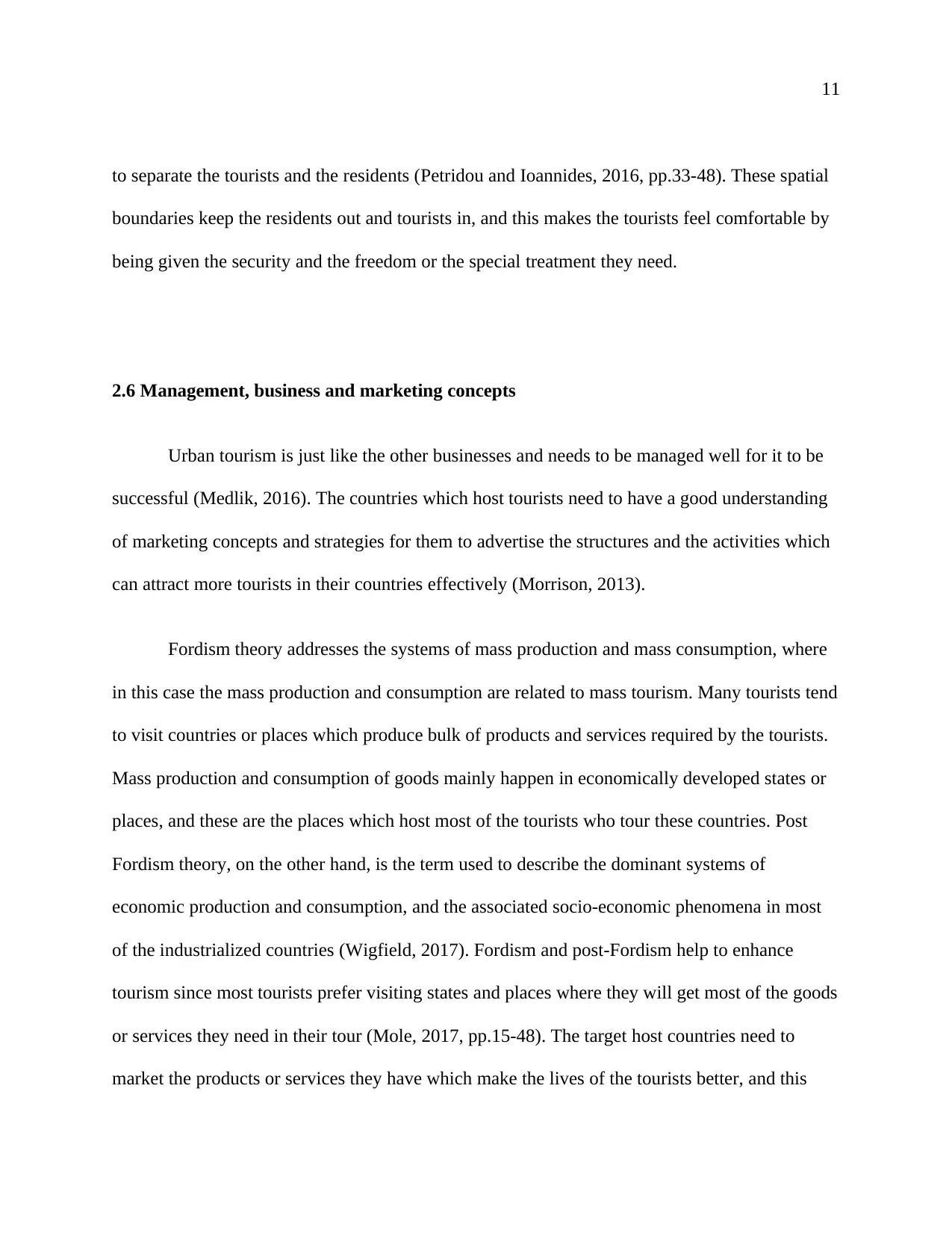
11
to separate the tourists and the residents (Petridou and Ioannides, 2016, pp.33-48). These spatial
boundaries keep the residents out and tourists in, and this makes the tourists feel comfortable by
being given the security and the freedom or the special treatment they need.
2.6 Management, business and marketing concepts
Urban tourism is just like the other businesses and needs to be managed well for it to be
successful (Medlik, 2016). The countries which host tourists need to have a good understanding
of marketing concepts and strategies for them to advertise the structures and the activities which
can attract more tourists in their countries effectively (Morrison, 2013).
Fordism theory addresses the systems of mass production and mass consumption, where
in this case the mass production and consumption are related to mass tourism. Many tourists tend
to visit countries or places which produce bulk of products and services required by the tourists.
Mass production and consumption of goods mainly happen in economically developed states or
places, and these are the places which host most of the tourists who tour these countries. Post
Fordism theory, on the other hand, is the term used to describe the dominant systems of
economic production and consumption, and the associated socio-economic phenomena in most
of the industrialized countries (Wigfield, 2017). Fordism and post-Fordism help to enhance
tourism since most tourists prefer visiting states and places where they will get most of the goods
or services they need in their tour (Mole, 2017, pp.15-48). The target host countries need to
market the products or services they have which make the lives of the tourists better, and this
to separate the tourists and the residents (Petridou and Ioannides, 2016, pp.33-48). These spatial
boundaries keep the residents out and tourists in, and this makes the tourists feel comfortable by
being given the security and the freedom or the special treatment they need.
2.6 Management, business and marketing concepts
Urban tourism is just like the other businesses and needs to be managed well for it to be
successful (Medlik, 2016). The countries which host tourists need to have a good understanding
of marketing concepts and strategies for them to advertise the structures and the activities which
can attract more tourists in their countries effectively (Morrison, 2013).
Fordism theory addresses the systems of mass production and mass consumption, where
in this case the mass production and consumption are related to mass tourism. Many tourists tend
to visit countries or places which produce bulk of products and services required by the tourists.
Mass production and consumption of goods mainly happen in economically developed states or
places, and these are the places which host most of the tourists who tour these countries. Post
Fordism theory, on the other hand, is the term used to describe the dominant systems of
economic production and consumption, and the associated socio-economic phenomena in most
of the industrialized countries (Wigfield, 2017). Fordism and post-Fordism help to enhance
tourism since most tourists prefer visiting states and places where they will get most of the goods
or services they need in their tour (Mole, 2017, pp.15-48). The target host countries need to
market the products or services they have which make the lives of the tourists better, and this
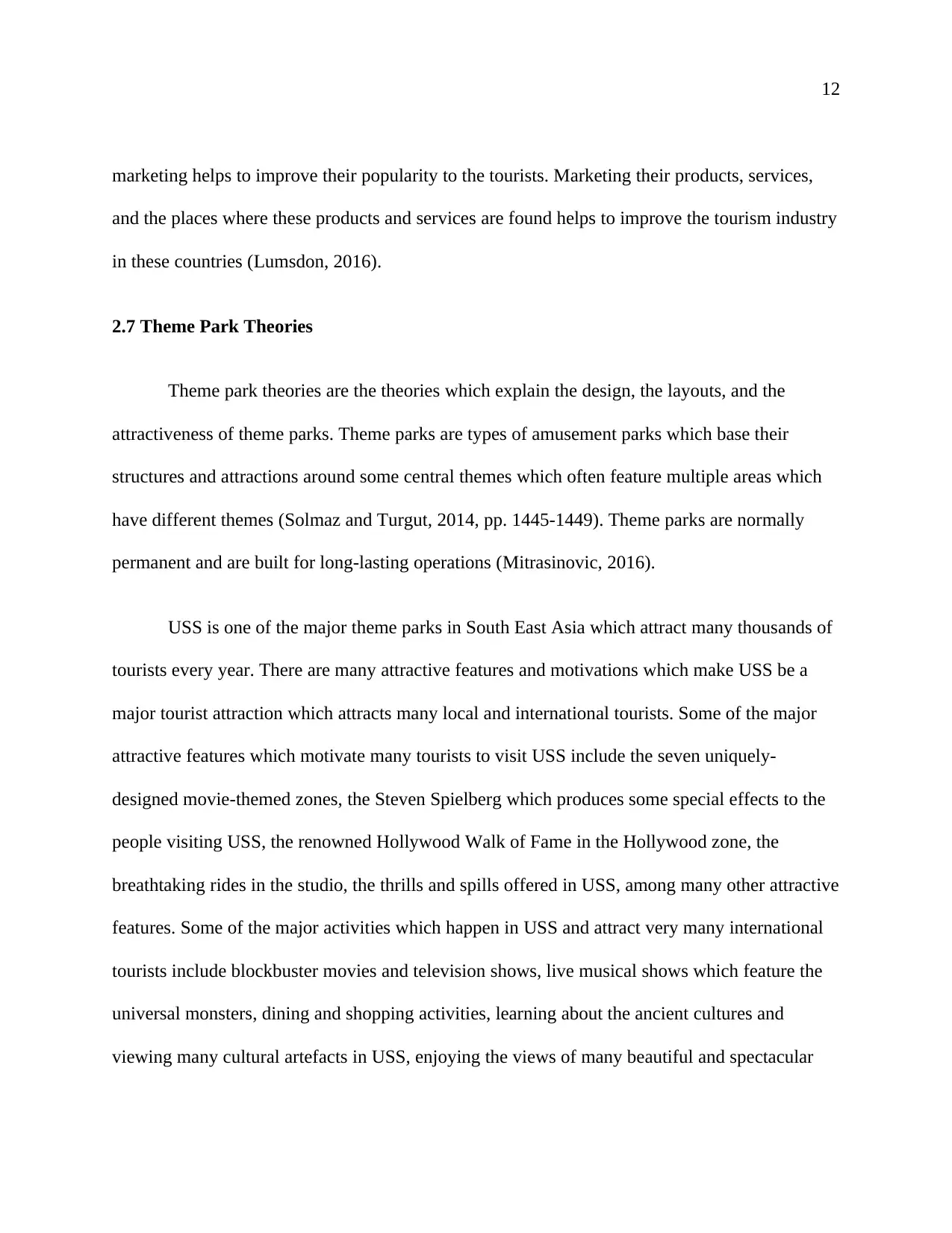
12
marketing helps to improve their popularity to the tourists. Marketing their products, services,
and the places where these products and services are found helps to improve the tourism industry
in these countries (Lumsdon, 2016).
2.7 Theme Park Theories
Theme park theories are the theories which explain the design, the layouts, and the
attractiveness of theme parks. Theme parks are types of amusement parks which base their
structures and attractions around some central themes which often feature multiple areas which
have different themes (Solmaz and Turgut, 2014, pp. 1445-1449). Theme parks are normally
permanent and are built for long-lasting operations (Mitrasinovic, 2016).
USS is one of the major theme parks in South East Asia which attract many thousands of
tourists every year. There are many attractive features and motivations which make USS be a
major tourist attraction which attracts many local and international tourists. Some of the major
attractive features which motivate many tourists to visit USS include the seven uniquely-
designed movie-themed zones, the Steven Spielberg which produces some special effects to the
people visiting USS, the renowned Hollywood Walk of Fame in the Hollywood zone, the
breathtaking rides in the studio, the thrills and spills offered in USS, among many other attractive
features. Some of the major activities which happen in USS and attract very many international
tourists include blockbuster movies and television shows, live musical shows which feature the
universal monsters, dining and shopping activities, learning about the ancient cultures and
viewing many cultural artefacts in USS, enjoying the views of many beautiful and spectacular
marketing helps to improve their popularity to the tourists. Marketing their products, services,
and the places where these products and services are found helps to improve the tourism industry
in these countries (Lumsdon, 2016).
2.7 Theme Park Theories
Theme park theories are the theories which explain the design, the layouts, and the
attractiveness of theme parks. Theme parks are types of amusement parks which base their
structures and attractions around some central themes which often feature multiple areas which
have different themes (Solmaz and Turgut, 2014, pp. 1445-1449). Theme parks are normally
permanent and are built for long-lasting operations (Mitrasinovic, 2016).
USS is one of the major theme parks in South East Asia which attract many thousands of
tourists every year. There are many attractive features and motivations which make USS be a
major tourist attraction which attracts many local and international tourists. Some of the major
attractive features which motivate many tourists to visit USS include the seven uniquely-
designed movie-themed zones, the Steven Spielberg which produces some special effects to the
people visiting USS, the renowned Hollywood Walk of Fame in the Hollywood zone, the
breathtaking rides in the studio, the thrills and spills offered in USS, among many other attractive
features. Some of the major activities which happen in USS and attract very many international
tourists include blockbuster movies and television shows, live musical shows which feature the
universal monsters, dining and shopping activities, learning about the ancient cultures and
viewing many cultural artefacts in USS, enjoying the views of many beautiful and spectacular
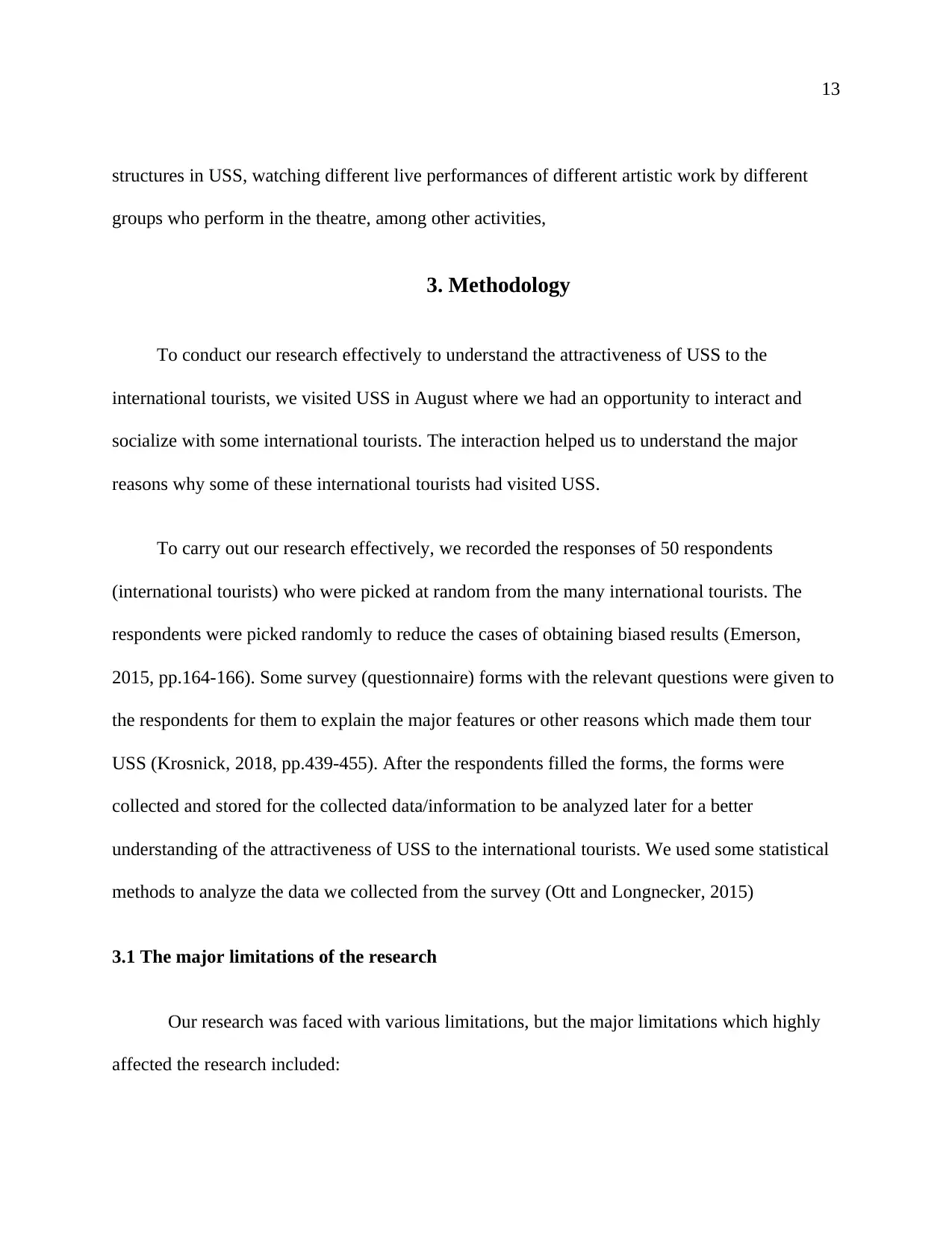
13
structures in USS, watching different live performances of different artistic work by different
groups who perform in the theatre, among other activities,
3. Methodology
To conduct our research effectively to understand the attractiveness of USS to the
international tourists, we visited USS in August where we had an opportunity to interact and
socialize with some international tourists. The interaction helped us to understand the major
reasons why some of these international tourists had visited USS.
To carry out our research effectively, we recorded the responses of 50 respondents
(international tourists) who were picked at random from the many international tourists. The
respondents were picked randomly to reduce the cases of obtaining biased results (Emerson,
2015, pp.164-166). Some survey (questionnaire) forms with the relevant questions were given to
the respondents for them to explain the major features or other reasons which made them tour
USS (Krosnick, 2018, pp.439-455). After the respondents filled the forms, the forms were
collected and stored for the collected data/information to be analyzed later for a better
understanding of the attractiveness of USS to the international tourists. We used some statistical
methods to analyze the data we collected from the survey (Ott and Longnecker, 2015)
3.1 The major limitations of the research
Our research was faced with various limitations, but the major limitations which highly
affected the research included:
structures in USS, watching different live performances of different artistic work by different
groups who perform in the theatre, among other activities,
3. Methodology
To conduct our research effectively to understand the attractiveness of USS to the
international tourists, we visited USS in August where we had an opportunity to interact and
socialize with some international tourists. The interaction helped us to understand the major
reasons why some of these international tourists had visited USS.
To carry out our research effectively, we recorded the responses of 50 respondents
(international tourists) who were picked at random from the many international tourists. The
respondents were picked randomly to reduce the cases of obtaining biased results (Emerson,
2015, pp.164-166). Some survey (questionnaire) forms with the relevant questions were given to
the respondents for them to explain the major features or other reasons which made them tour
USS (Krosnick, 2018, pp.439-455). After the respondents filled the forms, the forms were
collected and stored for the collected data/information to be analyzed later for a better
understanding of the attractiveness of USS to the international tourists. We used some statistical
methods to analyze the data we collected from the survey (Ott and Longnecker, 2015)
3.1 The major limitations of the research
Our research was faced with various limitations, but the major limitations which highly
affected the research included:
Paraphrase This Document
Need a fresh take? Get an instant paraphrase of this document with our AI Paraphraser
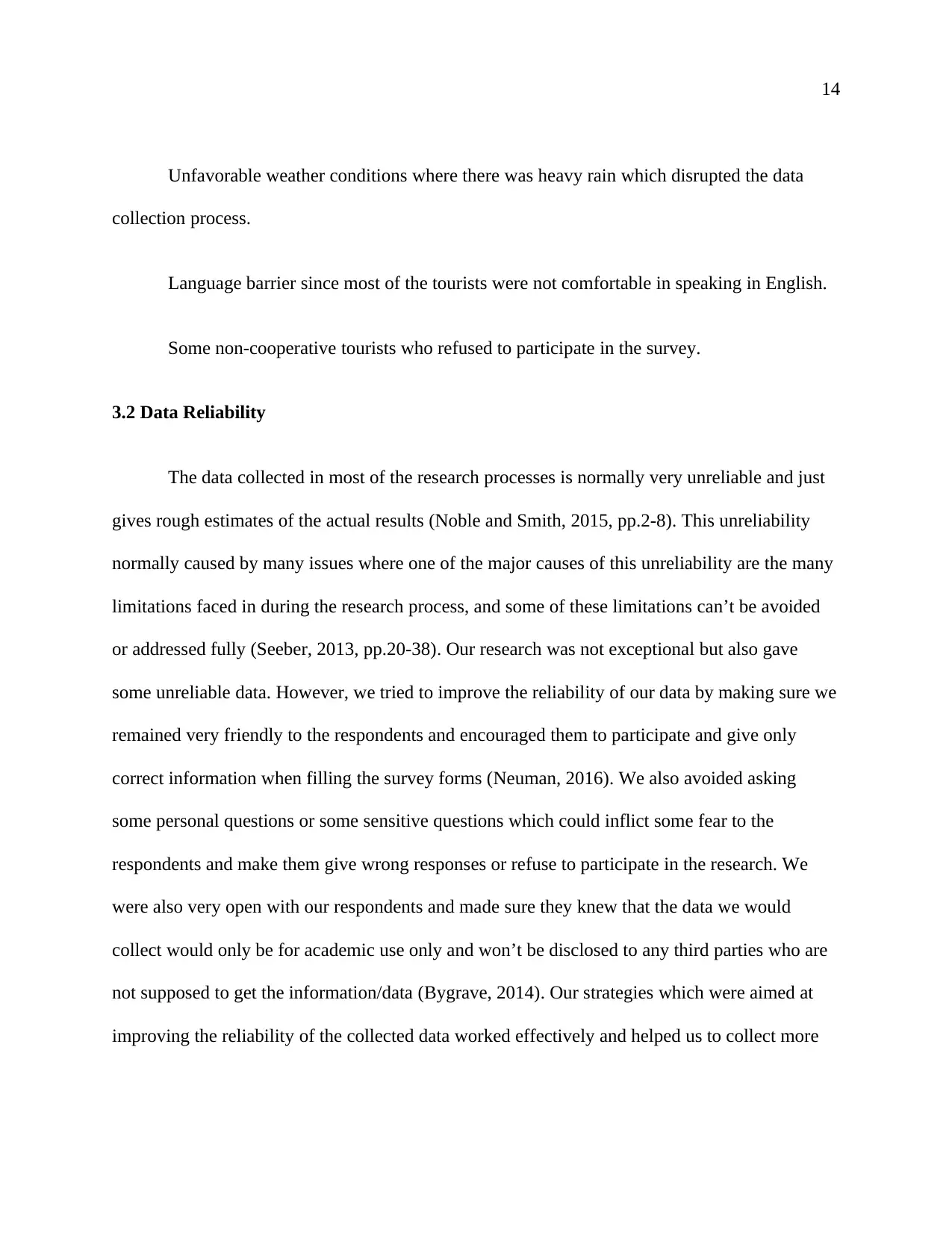
14
Unfavorable weather conditions where there was heavy rain which disrupted the data
collection process.
Language barrier since most of the tourists were not comfortable in speaking in English.
Some non-cooperative tourists who refused to participate in the survey.
3.2 Data Reliability
The data collected in most of the research processes is normally very unreliable and just
gives rough estimates of the actual results (Noble and Smith, 2015, pp.2-8). This unreliability
normally caused by many issues where one of the major causes of this unreliability are the many
limitations faced in during the research process, and some of these limitations can’t be avoided
or addressed fully (Seeber, 2013, pp.20-38). Our research was not exceptional but also gave
some unreliable data. However, we tried to improve the reliability of our data by making sure we
remained very friendly to the respondents and encouraged them to participate and give only
correct information when filling the survey forms (Neuman, 2016). We also avoided asking
some personal questions or some sensitive questions which could inflict some fear to the
respondents and make them give wrong responses or refuse to participate in the research. We
were also very open with our respondents and made sure they knew that the data we would
collect would only be for academic use only and won’t be disclosed to any third parties who are
not supposed to get the information/data (Bygrave, 2014). Our strategies which were aimed at
improving the reliability of the collected data worked effectively and helped us to collect more
Unfavorable weather conditions where there was heavy rain which disrupted the data
collection process.
Language barrier since most of the tourists were not comfortable in speaking in English.
Some non-cooperative tourists who refused to participate in the survey.
3.2 Data Reliability
The data collected in most of the research processes is normally very unreliable and just
gives rough estimates of the actual results (Noble and Smith, 2015, pp.2-8). This unreliability
normally caused by many issues where one of the major causes of this unreliability are the many
limitations faced in during the research process, and some of these limitations can’t be avoided
or addressed fully (Seeber, 2013, pp.20-38). Our research was not exceptional but also gave
some unreliable data. However, we tried to improve the reliability of our data by making sure we
remained very friendly to the respondents and encouraged them to participate and give only
correct information when filling the survey forms (Neuman, 2016). We also avoided asking
some personal questions or some sensitive questions which could inflict some fear to the
respondents and make them give wrong responses or refuse to participate in the research. We
were also very open with our respondents and made sure they knew that the data we would
collect would only be for academic use only and won’t be disclosed to any third parties who are
not supposed to get the information/data (Bygrave, 2014). Our strategies which were aimed at
improving the reliability of the collected data worked effectively and helped us to collect more
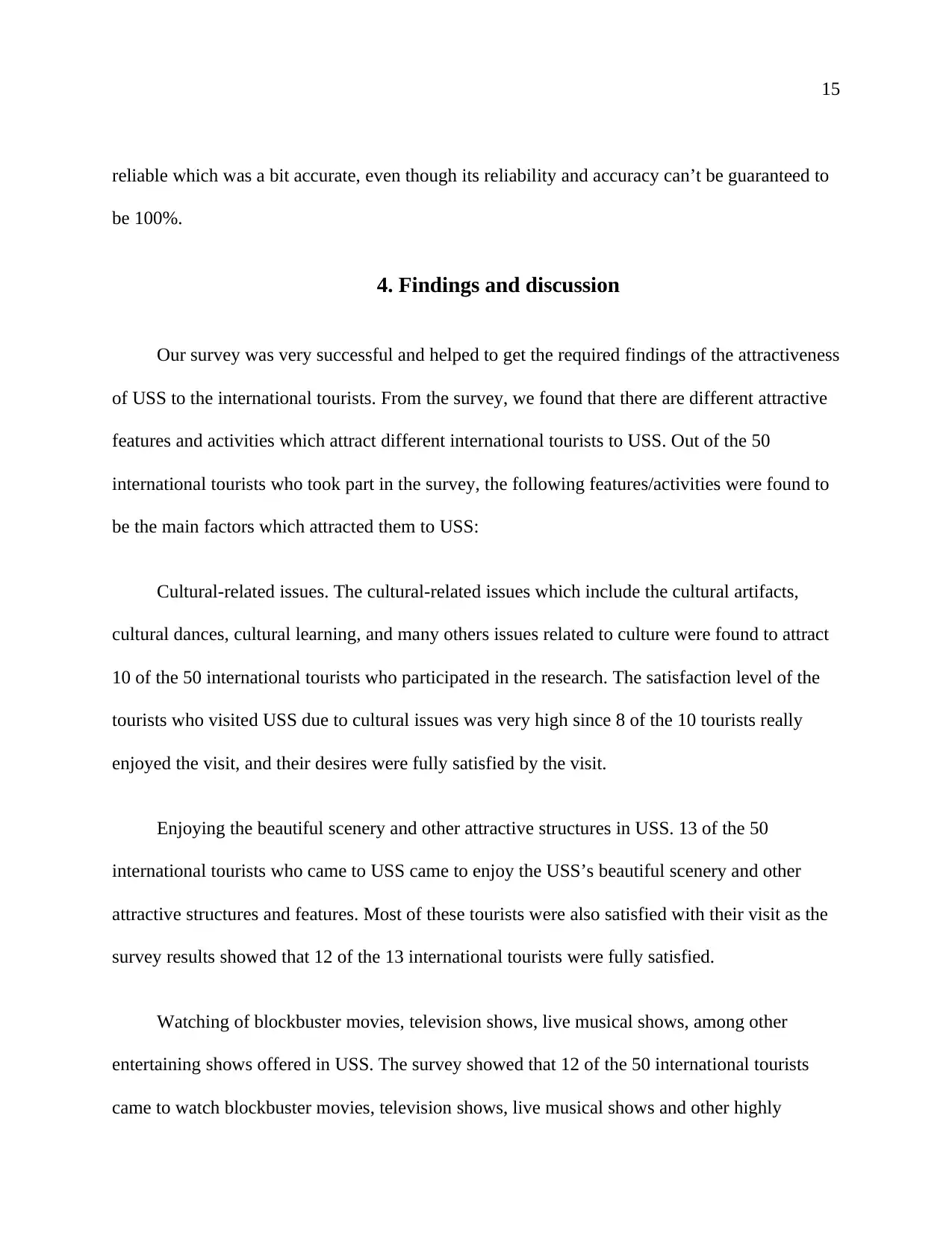
15
reliable which was a bit accurate, even though its reliability and accuracy can’t be guaranteed to
be 100%.
4. Findings and discussion
Our survey was very successful and helped to get the required findings of the attractiveness
of USS to the international tourists. From the survey, we found that there are different attractive
features and activities which attract different international tourists to USS. Out of the 50
international tourists who took part in the survey, the following features/activities were found to
be the main factors which attracted them to USS:
Cultural-related issues. The cultural-related issues which include the cultural artifacts,
cultural dances, cultural learning, and many others issues related to culture were found to attract
10 of the 50 international tourists who participated in the research. The satisfaction level of the
tourists who visited USS due to cultural issues was very high since 8 of the 10 tourists really
enjoyed the visit, and their desires were fully satisfied by the visit.
Enjoying the beautiful scenery and other attractive structures in USS. 13 of the 50
international tourists who came to USS came to enjoy the USS’s beautiful scenery and other
attractive structures and features. Most of these tourists were also satisfied with their visit as the
survey results showed that 12 of the 13 international tourists were fully satisfied.
Watching of blockbuster movies, television shows, live musical shows, among other
entertaining shows offered in USS. The survey showed that 12 of the 50 international tourists
came to watch blockbuster movies, television shows, live musical shows and other highly
reliable which was a bit accurate, even though its reliability and accuracy can’t be guaranteed to
be 100%.
4. Findings and discussion
Our survey was very successful and helped to get the required findings of the attractiveness
of USS to the international tourists. From the survey, we found that there are different attractive
features and activities which attract different international tourists to USS. Out of the 50
international tourists who took part in the survey, the following features/activities were found to
be the main factors which attracted them to USS:
Cultural-related issues. The cultural-related issues which include the cultural artifacts,
cultural dances, cultural learning, and many others issues related to culture were found to attract
10 of the 50 international tourists who participated in the research. The satisfaction level of the
tourists who visited USS due to cultural issues was very high since 8 of the 10 tourists really
enjoyed the visit, and their desires were fully satisfied by the visit.
Enjoying the beautiful scenery and other attractive structures in USS. 13 of the 50
international tourists who came to USS came to enjoy the USS’s beautiful scenery and other
attractive structures and features. Most of these tourists were also satisfied with their visit as the
survey results showed that 12 of the 13 international tourists were fully satisfied.
Watching of blockbuster movies, television shows, live musical shows, among other
entertaining shows offered in USS. The survey showed that 12 of the 50 international tourists
came to watch blockbuster movies, television shows, live musical shows and other highly
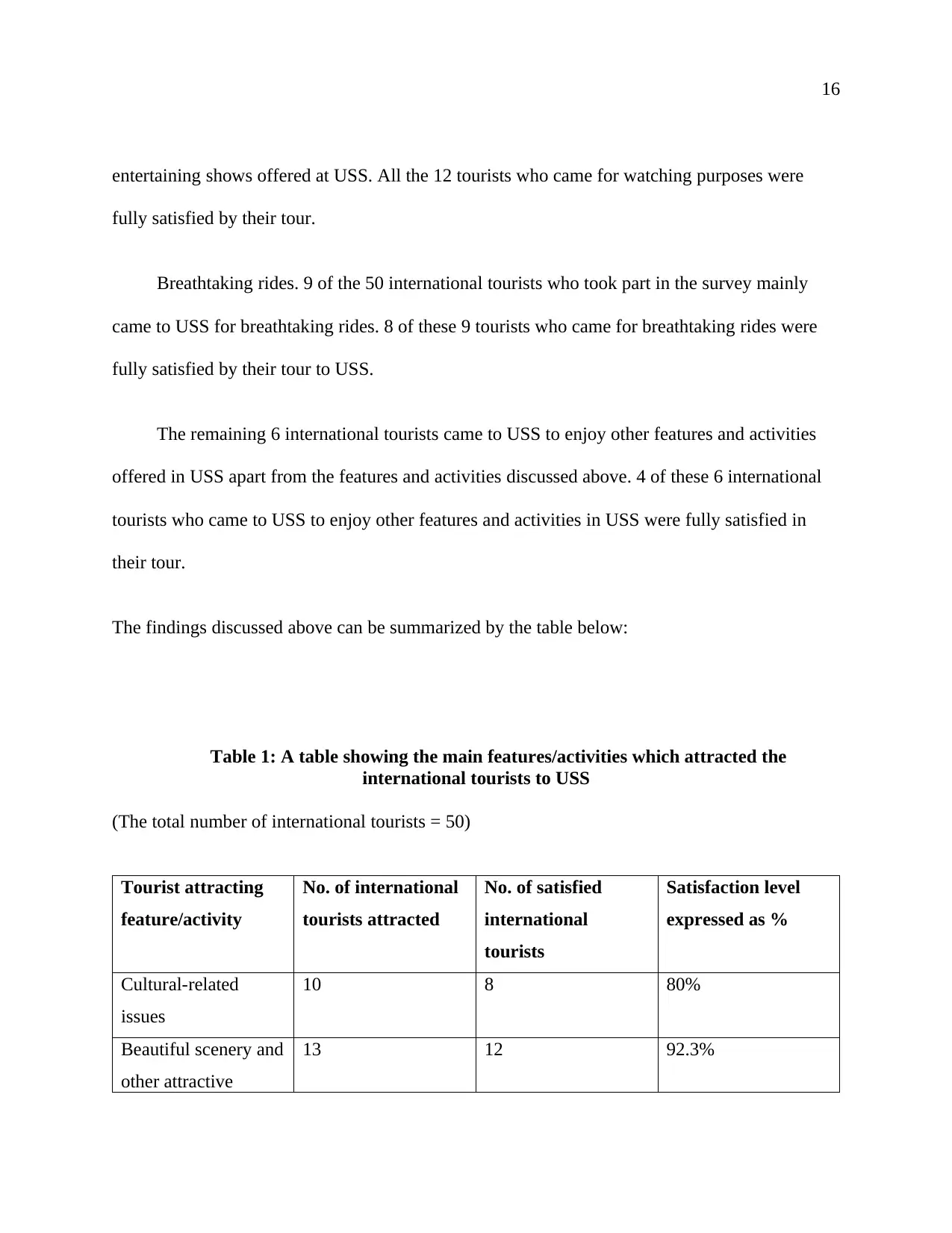
16
entertaining shows offered at USS. All the 12 tourists who came for watching purposes were
fully satisfied by their tour.
Breathtaking rides. 9 of the 50 international tourists who took part in the survey mainly
came to USS for breathtaking rides. 8 of these 9 tourists who came for breathtaking rides were
fully satisfied by their tour to USS.
The remaining 6 international tourists came to USS to enjoy other features and activities
offered in USS apart from the features and activities discussed above. 4 of these 6 international
tourists who came to USS to enjoy other features and activities in USS were fully satisfied in
their tour.
The findings discussed above can be summarized by the table below:
Table 1: A table showing the main features/activities which attracted the
international tourists to USS
(The total number of international tourists = 50)
Tourist attracting
feature/activity
No. of international
tourists attracted
No. of satisfied
international
tourists
Satisfaction level
expressed as %
Cultural-related
issues
10 8 80%
Beautiful scenery and
other attractive
13 12 92.3%
entertaining shows offered at USS. All the 12 tourists who came for watching purposes were
fully satisfied by their tour.
Breathtaking rides. 9 of the 50 international tourists who took part in the survey mainly
came to USS for breathtaking rides. 8 of these 9 tourists who came for breathtaking rides were
fully satisfied by their tour to USS.
The remaining 6 international tourists came to USS to enjoy other features and activities
offered in USS apart from the features and activities discussed above. 4 of these 6 international
tourists who came to USS to enjoy other features and activities in USS were fully satisfied in
their tour.
The findings discussed above can be summarized by the table below:
Table 1: A table showing the main features/activities which attracted the
international tourists to USS
(The total number of international tourists = 50)
Tourist attracting
feature/activity
No. of international
tourists attracted
No. of satisfied
international
tourists
Satisfaction level
expressed as %
Cultural-related
issues
10 8 80%
Beautiful scenery and
other attractive
13 12 92.3%
Secure Best Marks with AI Grader
Need help grading? Try our AI Grader for instant feedback on your assignments.
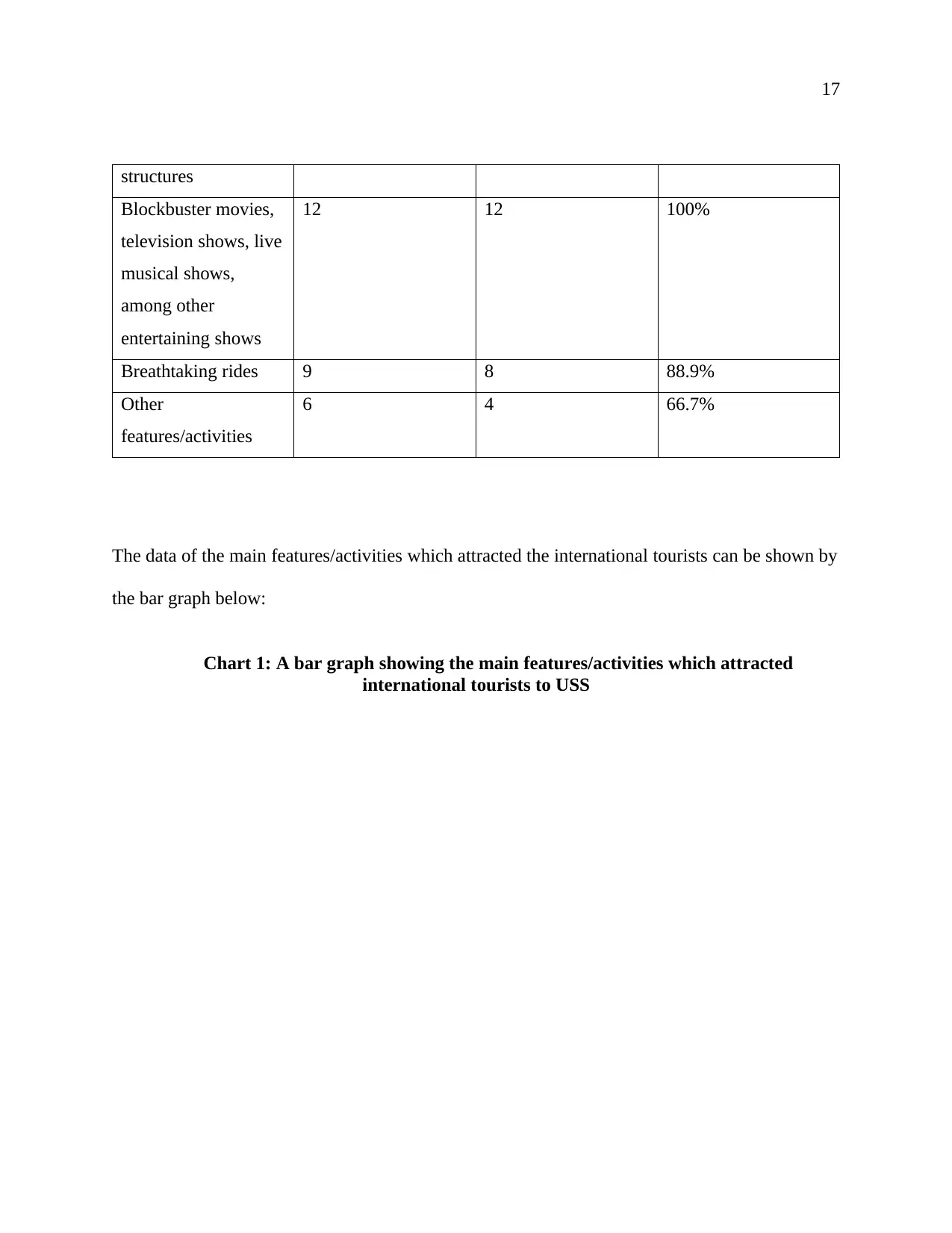
17
structures
Blockbuster movies,
television shows, live
musical shows,
among other
entertaining shows
12 12 100%
Breathtaking rides 9 8 88.9%
Other
features/activities
6 4 66.7%
The data of the main features/activities which attracted the international tourists can be shown by
the bar graph below:
Chart 1: A bar graph showing the main features/activities which attracted
international tourists to USS
structures
Blockbuster movies,
television shows, live
musical shows,
among other
entertaining shows
12 12 100%
Breathtaking rides 9 8 88.9%
Other
features/activities
6 4 66.7%
The data of the main features/activities which attracted the international tourists can be shown by
the bar graph below:
Chart 1: A bar graph showing the main features/activities which attracted
international tourists to USS
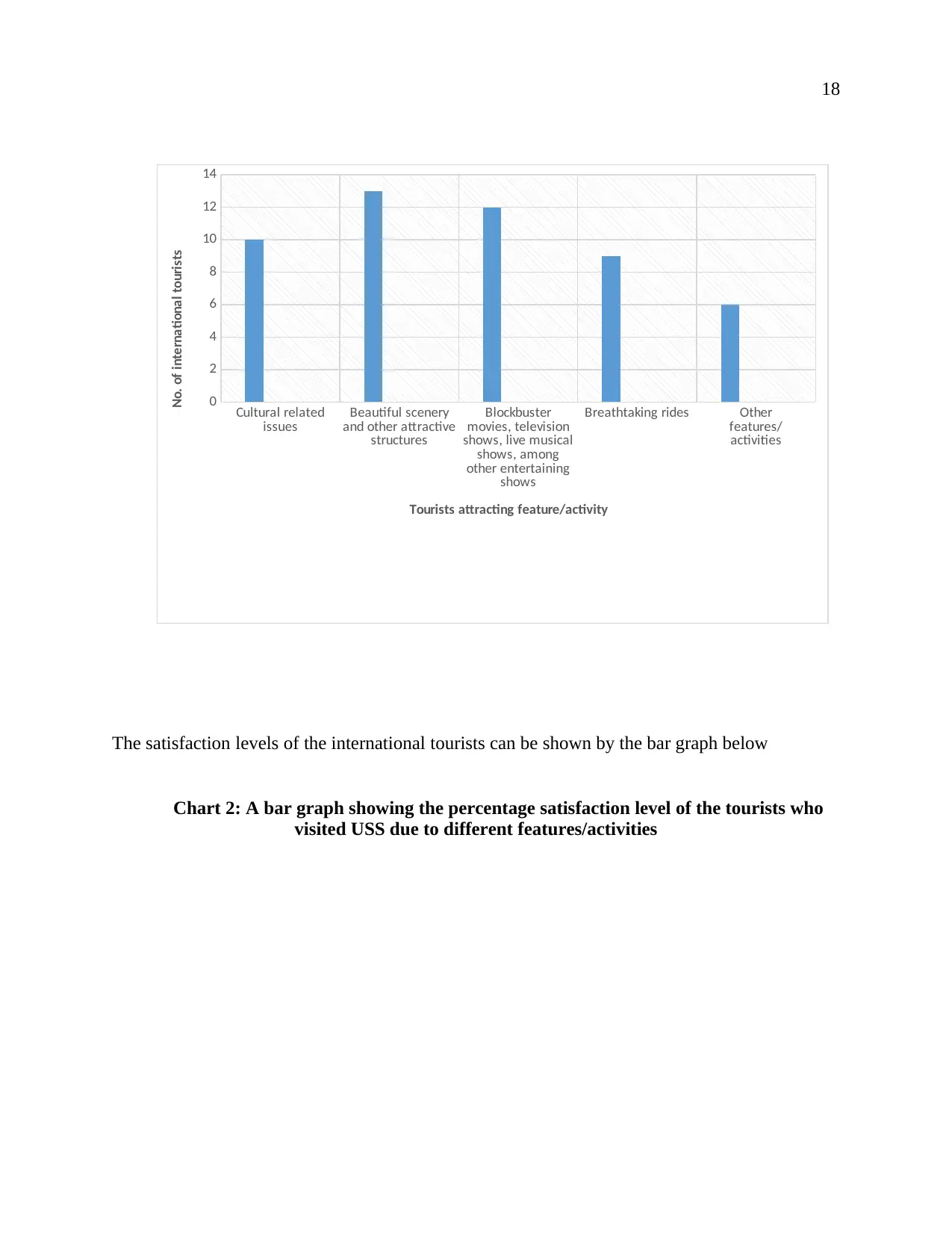
18
Cultural related
issues Beautiful scenery
and other attractive
structures
Blockbuster
movies, television
shows, live musical
shows, among
other entertaining
shows
Breathtaking rides Other
features/
activities
0
2
4
6
8
10
12
14
Tourists attracting feature/activity
No. of international tourists
The satisfaction levels of the international tourists can be shown by the bar graph below
Chart 2: A bar graph showing the percentage satisfaction level of the tourists who
visited USS due to different features/activities
Cultural related
issues Beautiful scenery
and other attractive
structures
Blockbuster
movies, television
shows, live musical
shows, among
other entertaining
shows
Breathtaking rides Other
features/
activities
0
2
4
6
8
10
12
14
Tourists attracting feature/activity
No. of international tourists
The satisfaction levels of the international tourists can be shown by the bar graph below
Chart 2: A bar graph showing the percentage satisfaction level of the tourists who
visited USS due to different features/activities
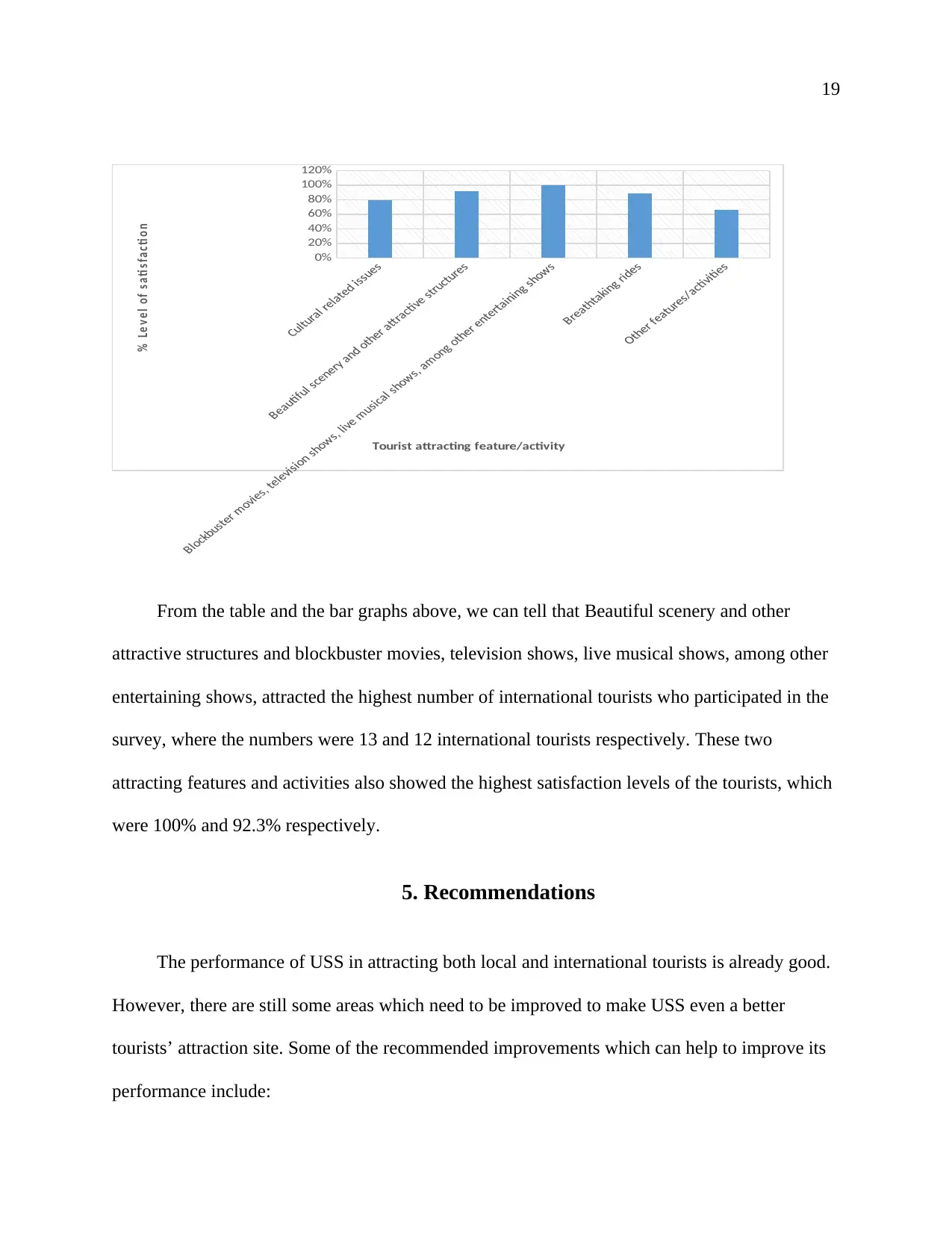
19
0%
20%
40%
60%
80%
100%
120%
Tourist attracting feature/activity
% L e v e l of s a ti s f a c ti on
From the table and the bar graphs above, we can tell that Beautiful scenery and other
attractive structures and blockbuster movies, television shows, live musical shows, among other
entertaining shows, attracted the highest number of international tourists who participated in the
survey, where the numbers were 13 and 12 international tourists respectively. These two
attracting features and activities also showed the highest satisfaction levels of the tourists, which
were 100% and 92.3% respectively.
5. Recommendations
The performance of USS in attracting both local and international tourists is already good.
However, there are still some areas which need to be improved to make USS even a better
tourists’ attraction site. Some of the recommended improvements which can help to improve its
performance include:
0%
20%
40%
60%
80%
100%
120%
Tourist attracting feature/activity
% L e v e l of s a ti s f a c ti on
From the table and the bar graphs above, we can tell that Beautiful scenery and other
attractive structures and blockbuster movies, television shows, live musical shows, among other
entertaining shows, attracted the highest number of international tourists who participated in the
survey, where the numbers were 13 and 12 international tourists respectively. These two
attracting features and activities also showed the highest satisfaction levels of the tourists, which
were 100% and 92.3% respectively.
5. Recommendations
The performance of USS in attracting both local and international tourists is already good.
However, there are still some areas which need to be improved to make USS even a better
tourists’ attraction site. Some of the recommended improvements which can help to improve its
performance include:
Paraphrase This Document
Need a fresh take? Get an instant paraphrase of this document with our AI Paraphraser
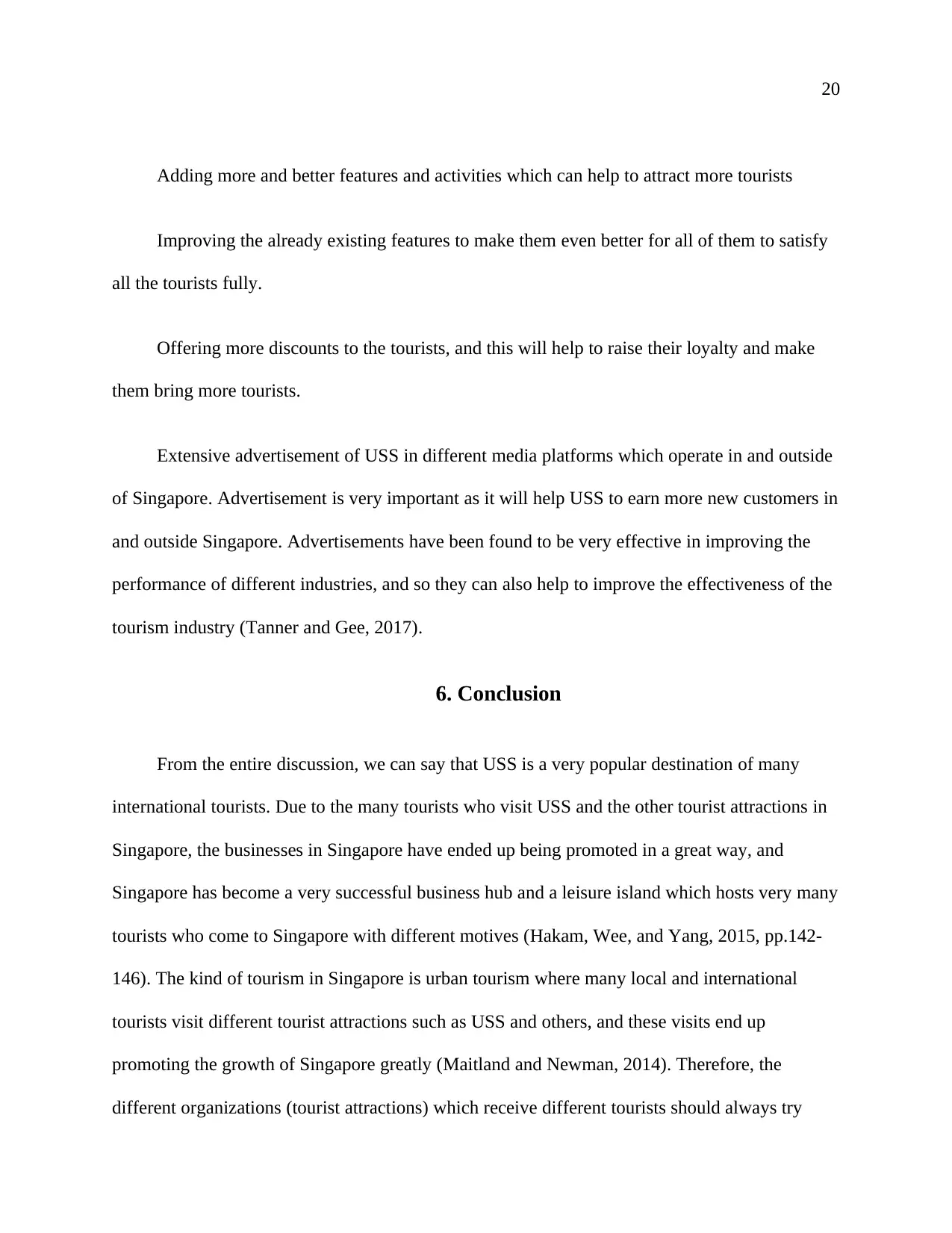
20
Adding more and better features and activities which can help to attract more tourists
Improving the already existing features to make them even better for all of them to satisfy
all the tourists fully.
Offering more discounts to the tourists, and this will help to raise their loyalty and make
them bring more tourists.
Extensive advertisement of USS in different media platforms which operate in and outside
of Singapore. Advertisement is very important as it will help USS to earn more new customers in
and outside Singapore. Advertisements have been found to be very effective in improving the
performance of different industries, and so they can also help to improve the effectiveness of the
tourism industry (Tanner and Gee, 2017).
6. Conclusion
From the entire discussion, we can say that USS is a very popular destination of many
international tourists. Due to the many tourists who visit USS and the other tourist attractions in
Singapore, the businesses in Singapore have ended up being promoted in a great way, and
Singapore has become a very successful business hub and a leisure island which hosts very many
tourists who come to Singapore with different motives (Hakam, Wee, and Yang, 2015, pp.142-
146). The kind of tourism in Singapore is urban tourism where many local and international
tourists visit different tourist attractions such as USS and others, and these visits end up
promoting the growth of Singapore greatly (Maitland and Newman, 2014). Therefore, the
different organizations (tourist attractions) which receive different tourists should always try
Adding more and better features and activities which can help to attract more tourists
Improving the already existing features to make them even better for all of them to satisfy
all the tourists fully.
Offering more discounts to the tourists, and this will help to raise their loyalty and make
them bring more tourists.
Extensive advertisement of USS in different media platforms which operate in and outside
of Singapore. Advertisement is very important as it will help USS to earn more new customers in
and outside Singapore. Advertisements have been found to be very effective in improving the
performance of different industries, and so they can also help to improve the effectiveness of the
tourism industry (Tanner and Gee, 2017).
6. Conclusion
From the entire discussion, we can say that USS is a very popular destination of many
international tourists. Due to the many tourists who visit USS and the other tourist attractions in
Singapore, the businesses in Singapore have ended up being promoted in a great way, and
Singapore has become a very successful business hub and a leisure island which hosts very many
tourists who come to Singapore with different motives (Hakam, Wee, and Yang, 2015, pp.142-
146). The kind of tourism in Singapore is urban tourism where many local and international
tourists visit different tourist attractions such as USS and others, and these visits end up
promoting the growth of Singapore greatly (Maitland and Newman, 2014). Therefore, the
different organizations (tourist attractions) which receive different tourists should always try
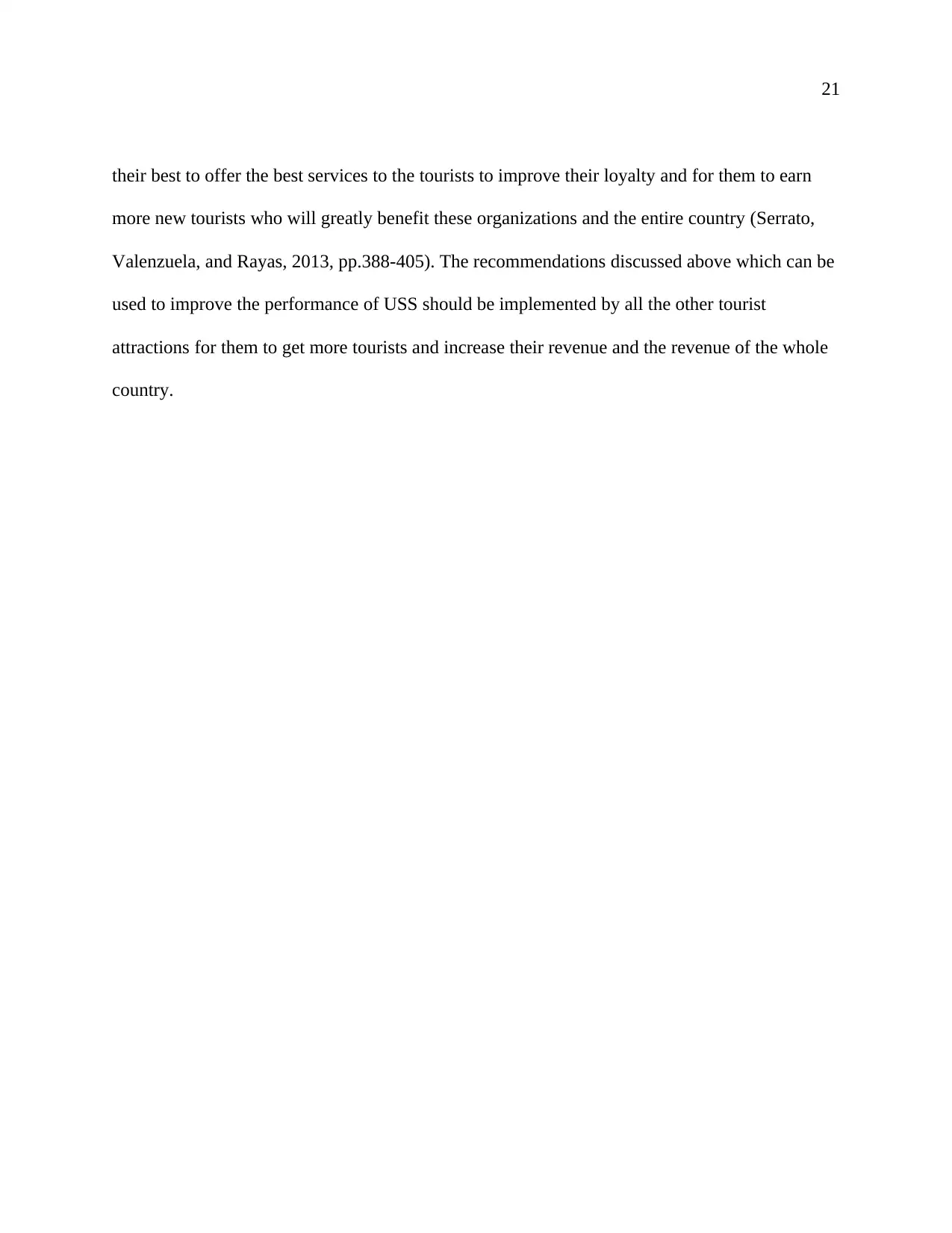
21
their best to offer the best services to the tourists to improve their loyalty and for them to earn
more new tourists who will greatly benefit these organizations and the entire country (Serrato,
Valenzuela, and Rayas, 2013, pp.388-405). The recommendations discussed above which can be
used to improve the performance of USS should be implemented by all the other tourist
attractions for them to get more tourists and increase their revenue and the revenue of the whole
country.
their best to offer the best services to the tourists to improve their loyalty and for them to earn
more new tourists who will greatly benefit these organizations and the entire country (Serrato,
Valenzuela, and Rayas, 2013, pp.388-405). The recommendations discussed above which can be
used to improve the performance of USS should be implemented by all the other tourist
attractions for them to get more tourists and increase their revenue and the revenue of the whole
country.
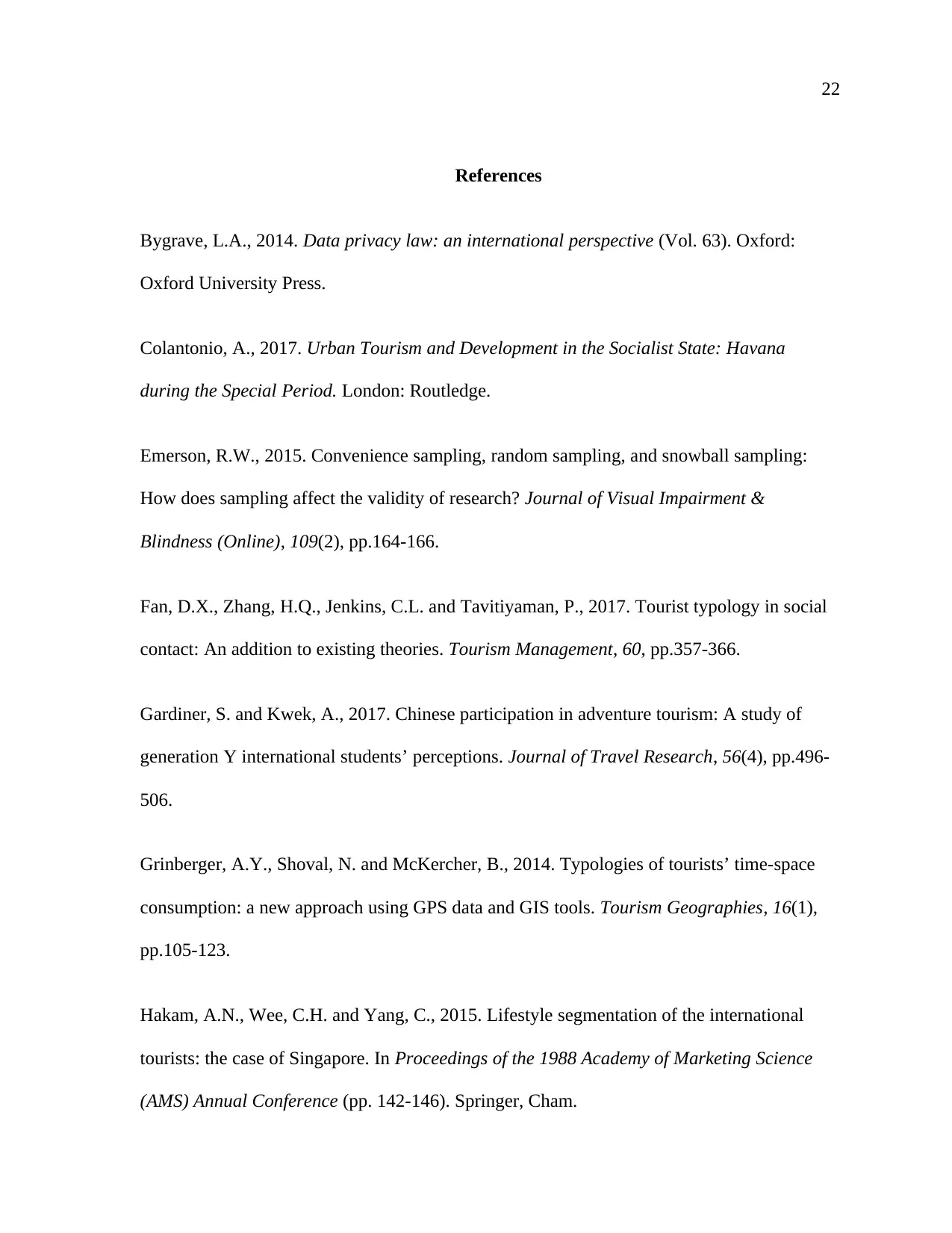
22
References
Bygrave, L.A., 2014. Data privacy law: an international perspective (Vol. 63). Oxford:
Oxford University Press.
Colantonio, A., 2017. Urban Tourism and Development in the Socialist State: Havana
during the Special Period. London: Routledge.
Emerson, R.W., 2015. Convenience sampling, random sampling, and snowball sampling:
How does sampling affect the validity of research? Journal of Visual Impairment &
Blindness (Online), 109(2), pp.164-166.
Fan, D.X., Zhang, H.Q., Jenkins, C.L. and Tavitiyaman, P., 2017. Tourist typology in social
contact: An addition to existing theories. Tourism Management, 60, pp.357-366.
Gardiner, S. and Kwek, A., 2017. Chinese participation in adventure tourism: A study of
generation Y international students’ perceptions. Journal of Travel Research, 56(4), pp.496-
506.
Grinberger, A.Y., Shoval, N. and McKercher, B., 2014. Typologies of tourists’ time-space
consumption: a new approach using GPS data and GIS tools. Tourism Geographies, 16(1),
pp.105-123.
Hakam, A.N., Wee, C.H. and Yang, C., 2015. Lifestyle segmentation of the international
tourists: the case of Singapore. In Proceedings of the 1988 Academy of Marketing Science
(AMS) Annual Conference (pp. 142-146). Springer, Cham.
References
Bygrave, L.A., 2014. Data privacy law: an international perspective (Vol. 63). Oxford:
Oxford University Press.
Colantonio, A., 2017. Urban Tourism and Development in the Socialist State: Havana
during the Special Period. London: Routledge.
Emerson, R.W., 2015. Convenience sampling, random sampling, and snowball sampling:
How does sampling affect the validity of research? Journal of Visual Impairment &
Blindness (Online), 109(2), pp.164-166.
Fan, D.X., Zhang, H.Q., Jenkins, C.L. and Tavitiyaman, P., 2017. Tourist typology in social
contact: An addition to existing theories. Tourism Management, 60, pp.357-366.
Gardiner, S. and Kwek, A., 2017. Chinese participation in adventure tourism: A study of
generation Y international students’ perceptions. Journal of Travel Research, 56(4), pp.496-
506.
Grinberger, A.Y., Shoval, N. and McKercher, B., 2014. Typologies of tourists’ time-space
consumption: a new approach using GPS data and GIS tools. Tourism Geographies, 16(1),
pp.105-123.
Hakam, A.N., Wee, C.H. and Yang, C., 2015. Lifestyle segmentation of the international
tourists: the case of Singapore. In Proceedings of the 1988 Academy of Marketing Science
(AMS) Annual Conference (pp. 142-146). Springer, Cham.
Secure Best Marks with AI Grader
Need help grading? Try our AI Grader for instant feedback on your assignments.
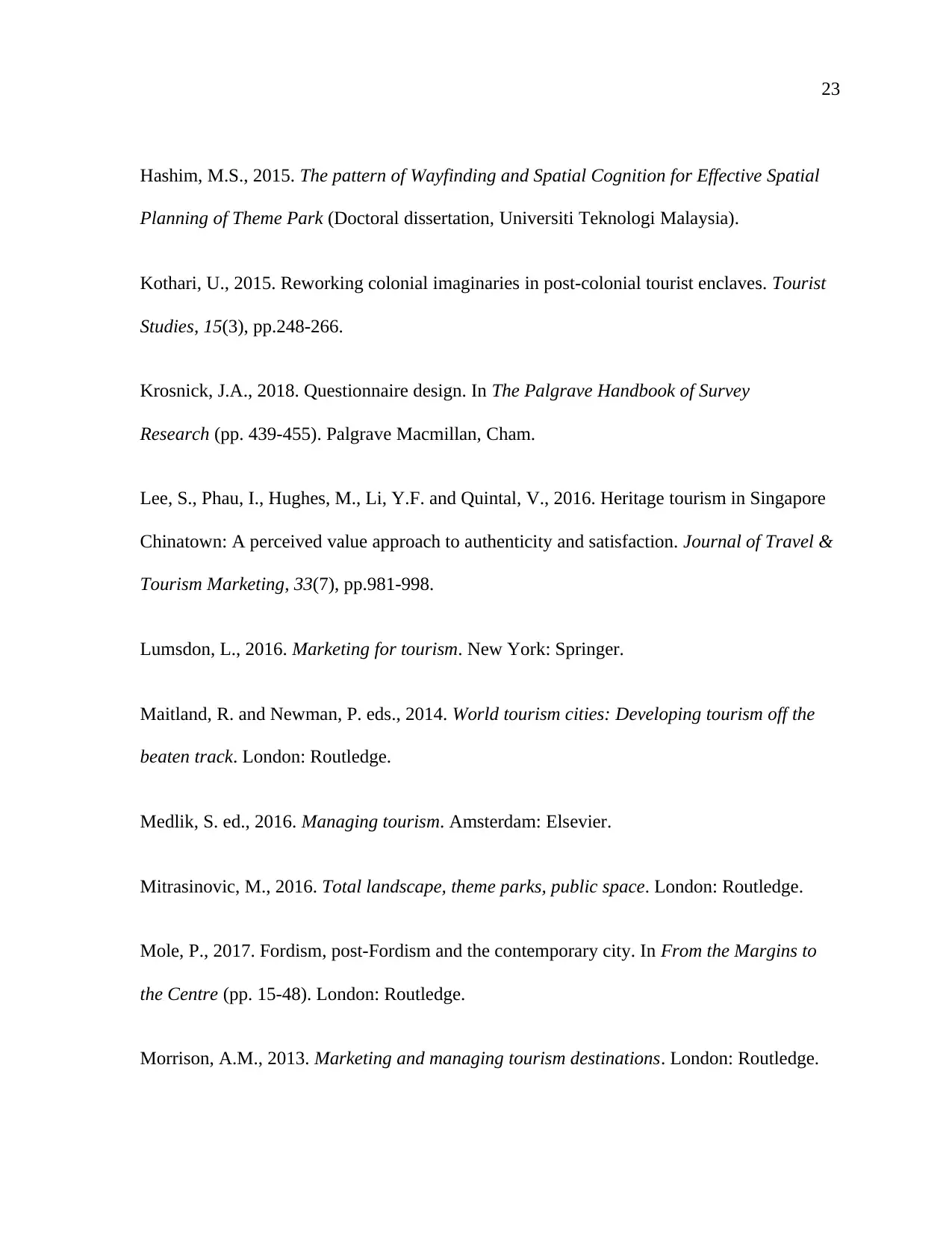
23
Hashim, M.S., 2015. The pattern of Wayfinding and Spatial Cognition for Effective Spatial
Planning of Theme Park (Doctoral dissertation, Universiti Teknologi Malaysia).
Kothari, U., 2015. Reworking colonial imaginaries in post-colonial tourist enclaves. Tourist
Studies, 15(3), pp.248-266.
Krosnick, J.A., 2018. Questionnaire design. In The Palgrave Handbook of Survey
Research (pp. 439-455). Palgrave Macmillan, Cham.
Lee, S., Phau, I., Hughes, M., Li, Y.F. and Quintal, V., 2016. Heritage tourism in Singapore
Chinatown: A perceived value approach to authenticity and satisfaction. Journal of Travel &
Tourism Marketing, 33(7), pp.981-998.
Lumsdon, L., 2016. Marketing for tourism. New York: Springer.
Maitland, R. and Newman, P. eds., 2014. World tourism cities: Developing tourism off the
beaten track. London: Routledge.
Medlik, S. ed., 2016. Managing tourism. Amsterdam: Elsevier.
Mitrasinovic, M., 2016. Total landscape, theme parks, public space. London: Routledge.
Mole, P., 2017. Fordism, post-Fordism and the contemporary city. In From the Margins to
the Centre (pp. 15-48). London: Routledge.
Morrison, A.M., 2013. Marketing and managing tourism destinations. London: Routledge.
Hashim, M.S., 2015. The pattern of Wayfinding and Spatial Cognition for Effective Spatial
Planning of Theme Park (Doctoral dissertation, Universiti Teknologi Malaysia).
Kothari, U., 2015. Reworking colonial imaginaries in post-colonial tourist enclaves. Tourist
Studies, 15(3), pp.248-266.
Krosnick, J.A., 2018. Questionnaire design. In The Palgrave Handbook of Survey
Research (pp. 439-455). Palgrave Macmillan, Cham.
Lee, S., Phau, I., Hughes, M., Li, Y.F. and Quintal, V., 2016. Heritage tourism in Singapore
Chinatown: A perceived value approach to authenticity and satisfaction. Journal of Travel &
Tourism Marketing, 33(7), pp.981-998.
Lumsdon, L., 2016. Marketing for tourism. New York: Springer.
Maitland, R. and Newman, P. eds., 2014. World tourism cities: Developing tourism off the
beaten track. London: Routledge.
Medlik, S. ed., 2016. Managing tourism. Amsterdam: Elsevier.
Mitrasinovic, M., 2016. Total landscape, theme parks, public space. London: Routledge.
Mole, P., 2017. Fordism, post-Fordism and the contemporary city. In From the Margins to
the Centre (pp. 15-48). London: Routledge.
Morrison, A.M., 2013. Marketing and managing tourism destinations. London: Routledge.
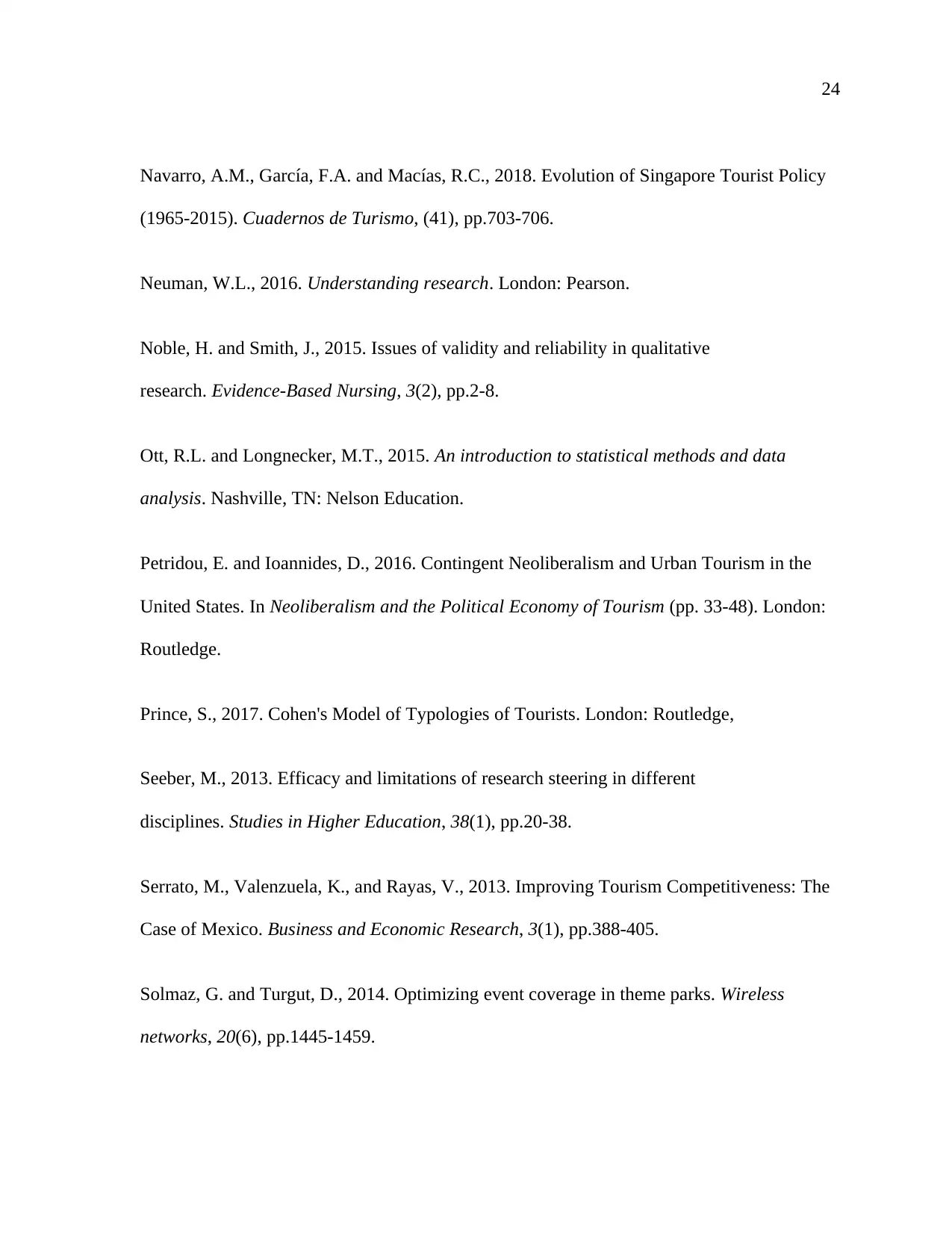
24
Navarro, A.M., García, F.A. and Macías, R.C., 2018. Evolution of Singapore Tourist Policy
(1965-2015). Cuadernos de Turismo, (41), pp.703-706.
Neuman, W.L., 2016. Understanding research. London: Pearson.
Noble, H. and Smith, J., 2015. Issues of validity and reliability in qualitative
research. Evidence-Based Nursing, 3(2), pp.2-8.
Ott, R.L. and Longnecker, M.T., 2015. An introduction to statistical methods and data
analysis. Nashville, TN: Nelson Education.
Petridou, E. and Ioannides, D., 2016. Contingent Neoliberalism and Urban Tourism in the
United States. In Neoliberalism and the Political Economy of Tourism (pp. 33-48). London:
Routledge.
Prince, S., 2017. Cohen's Model of Typologies of Tourists. London: Routledge,
Seeber, M., 2013. Efficacy and limitations of research steering in different
disciplines. Studies in Higher Education, 38(1), pp.20-38.
Serrato, M., Valenzuela, K., and Rayas, V., 2013. Improving Tourism Competitiveness: The
Case of Mexico. Business and Economic Research, 3(1), pp.388-405.
Solmaz, G. and Turgut, D., 2014. Optimizing event coverage in theme parks. Wireless
networks, 20(6), pp.1445-1459.
Navarro, A.M., García, F.A. and Macías, R.C., 2018. Evolution of Singapore Tourist Policy
(1965-2015). Cuadernos de Turismo, (41), pp.703-706.
Neuman, W.L., 2016. Understanding research. London: Pearson.
Noble, H. and Smith, J., 2015. Issues of validity and reliability in qualitative
research. Evidence-Based Nursing, 3(2), pp.2-8.
Ott, R.L. and Longnecker, M.T., 2015. An introduction to statistical methods and data
analysis. Nashville, TN: Nelson Education.
Petridou, E. and Ioannides, D., 2016. Contingent Neoliberalism and Urban Tourism in the
United States. In Neoliberalism and the Political Economy of Tourism (pp. 33-48). London:
Routledge.
Prince, S., 2017. Cohen's Model of Typologies of Tourists. London: Routledge,
Seeber, M., 2013. Efficacy and limitations of research steering in different
disciplines. Studies in Higher Education, 38(1), pp.20-38.
Serrato, M., Valenzuela, K., and Rayas, V., 2013. Improving Tourism Competitiveness: The
Case of Mexico. Business and Economic Research, 3(1), pp.388-405.
Solmaz, G. and Turgut, D., 2014. Optimizing event coverage in theme parks. Wireless
networks, 20(6), pp.1445-1459.
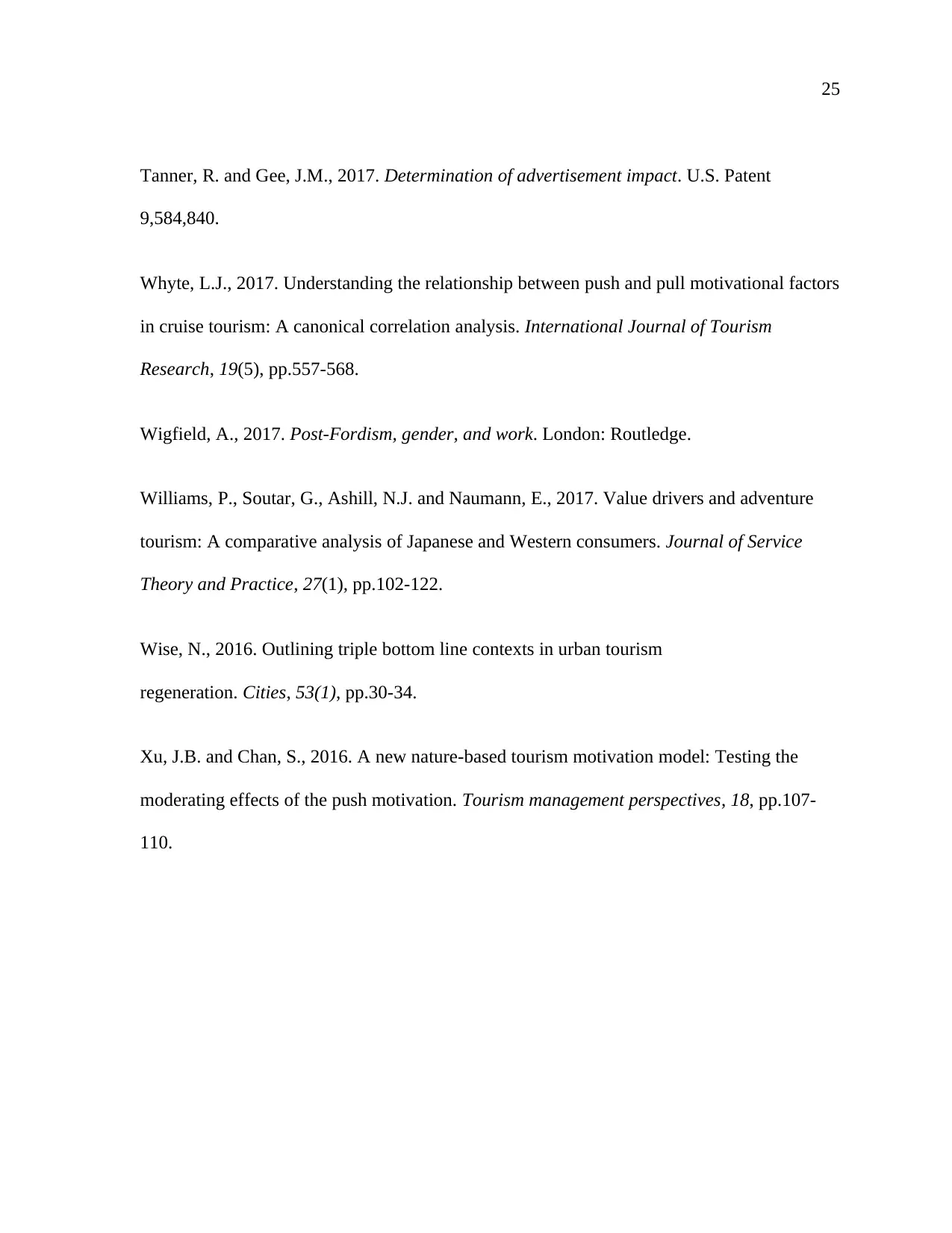
25
Tanner, R. and Gee, J.M., 2017. Determination of advertisement impact. U.S. Patent
9,584,840.
Whyte, L.J., 2017. Understanding the relationship between push and pull motivational factors
in cruise tourism: A canonical correlation analysis. International Journal of Tourism
Research, 19(5), pp.557-568.
Wigfield, A., 2017. Post-Fordism, gender, and work. London: Routledge.
Williams, P., Soutar, G., Ashill, N.J. and Naumann, E., 2017. Value drivers and adventure
tourism: A comparative analysis of Japanese and Western consumers. Journal of Service
Theory and Practice, 27(1), pp.102-122.
Wise, N., 2016. Outlining triple bottom line contexts in urban tourism
regeneration. Cities, 53(1), pp.30-34.
Xu, J.B. and Chan, S., 2016. A new nature-based tourism motivation model: Testing the
moderating effects of the push motivation. Tourism management perspectives, 18, pp.107-
110.
Tanner, R. and Gee, J.M., 2017. Determination of advertisement impact. U.S. Patent
9,584,840.
Whyte, L.J., 2017. Understanding the relationship between push and pull motivational factors
in cruise tourism: A canonical correlation analysis. International Journal of Tourism
Research, 19(5), pp.557-568.
Wigfield, A., 2017. Post-Fordism, gender, and work. London: Routledge.
Williams, P., Soutar, G., Ashill, N.J. and Naumann, E., 2017. Value drivers and adventure
tourism: A comparative analysis of Japanese and Western consumers. Journal of Service
Theory and Practice, 27(1), pp.102-122.
Wise, N., 2016. Outlining triple bottom line contexts in urban tourism
regeneration. Cities, 53(1), pp.30-34.
Xu, J.B. and Chan, S., 2016. A new nature-based tourism motivation model: Testing the
moderating effects of the push motivation. Tourism management perspectives, 18, pp.107-
110.
1 out of 25
Related Documents
Your All-in-One AI-Powered Toolkit for Academic Success.
+13062052269
info@desklib.com
Available 24*7 on WhatsApp / Email
![[object Object]](/_next/static/media/star-bottom.7253800d.svg)
Unlock your academic potential
© 2024 | Zucol Services PVT LTD | All rights reserved.





